A well-chosen deck lattice does more than hide structural beams—it frames your outdoor room, guides breezes, filters sun, and turns a plain platform into a private retreat rich with texture and character. From classic crisscross skirting to living walls that bloom through the seasons, today’s materials span wood, composite, vinyl, metal, and even solar-powered hybrids, so you can match any budget, code requirement, or creative whim. Below, you’ll find 20 distinct deck lattice ideas, each wrapped in practical tips that cover durability, maintenance, ventilation, and local-code basics. Dive in and discover the pattern that will elevate your deck from functional to unforgettable.
1. Classic Diagonal Deck Lattice Skirt

A time-honored diagonal deck lattice instantly delivers cottage charm while masking the under-deck void. Opt for rot-resistant pressure-treated boards or PVC panels so ground moisture can’t sneak in, then frame the grid with 1×4 trim for a crisp, finished edge. Ventilation gaps in the diagonal pattern encourage airflow that helps keep joists dry—key to meeting most local building-code moisture standards TimberTech This Old House. Stain or paint the lattice before installation to hit those hard-to-reach inner corners, and attach panels with stainless-steel screws set into predrilled holes to prevent splitting. Finally, leave a 1-inch space above soil or mulch to discourage rot and pests while keeping the skirt visually grounded Trex Rain Escape.
2. Vertical-Slat Deck Lattice for a Contemporary Facade
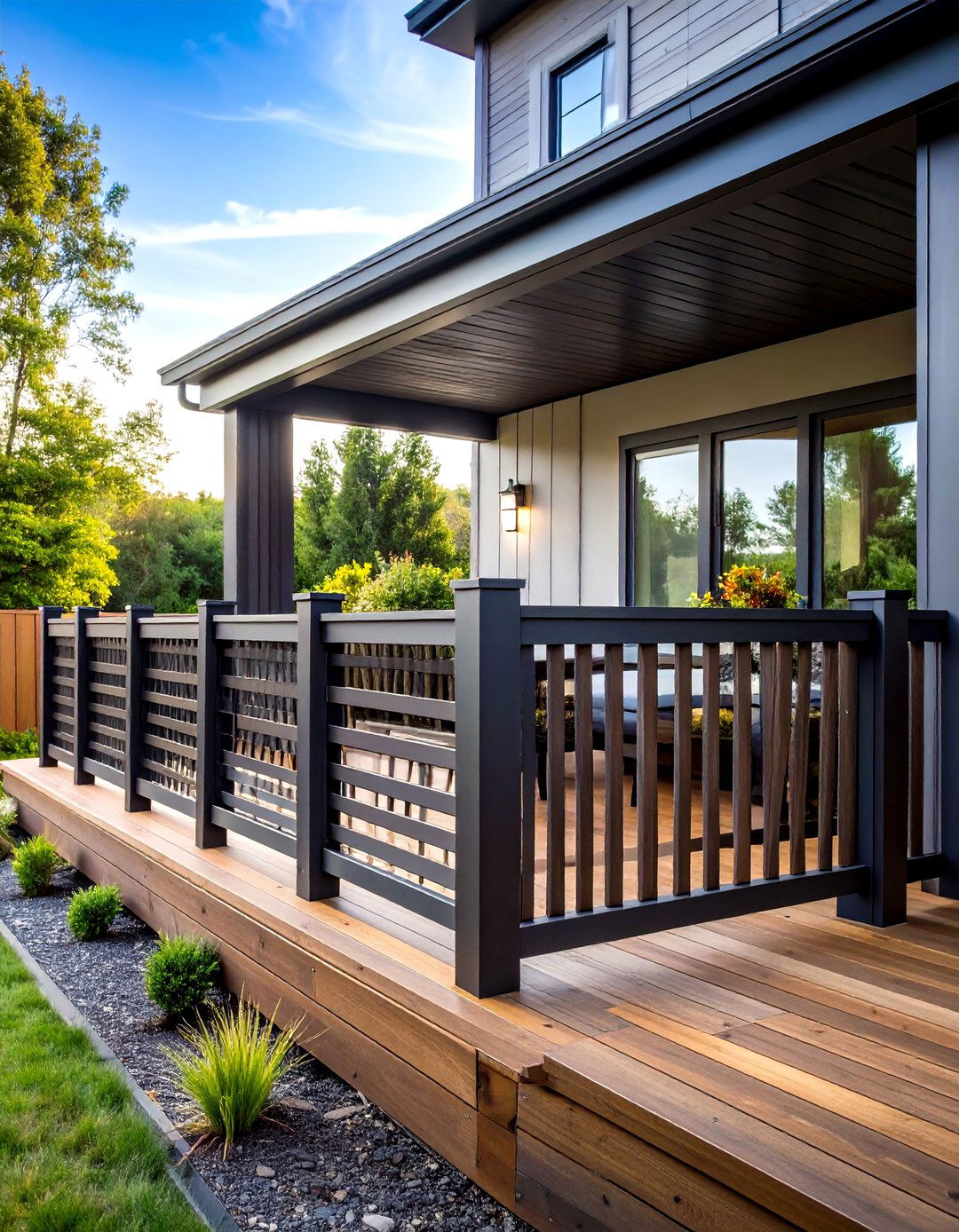
Where horizontal deck boards dominate, a clean vertical-slat deck lattice adds a stylish counterpoint that feels modern yet timeless. Using 1×2 battens spaced ¾-inch apart, you’ll create crisp lines that make your deck appear taller—ideal for low-profile platforms. Latest skirting trend reports show vertical lattice as a leading look for 2025, prized for its ability to pair with minimalist railings and dark, saturated stains DeckGuru Elgin Ildeck Contractors. Install battens on a hidden backer frame so fasteners remain unseen, and finish with UV-resistant exterior paint in matte black or charcoal for an upscale vibe that resists fading. Remember to include a removable panel for access to utilities beneath the deck.
3. Bold-Color Composite Deck Lattice Panels
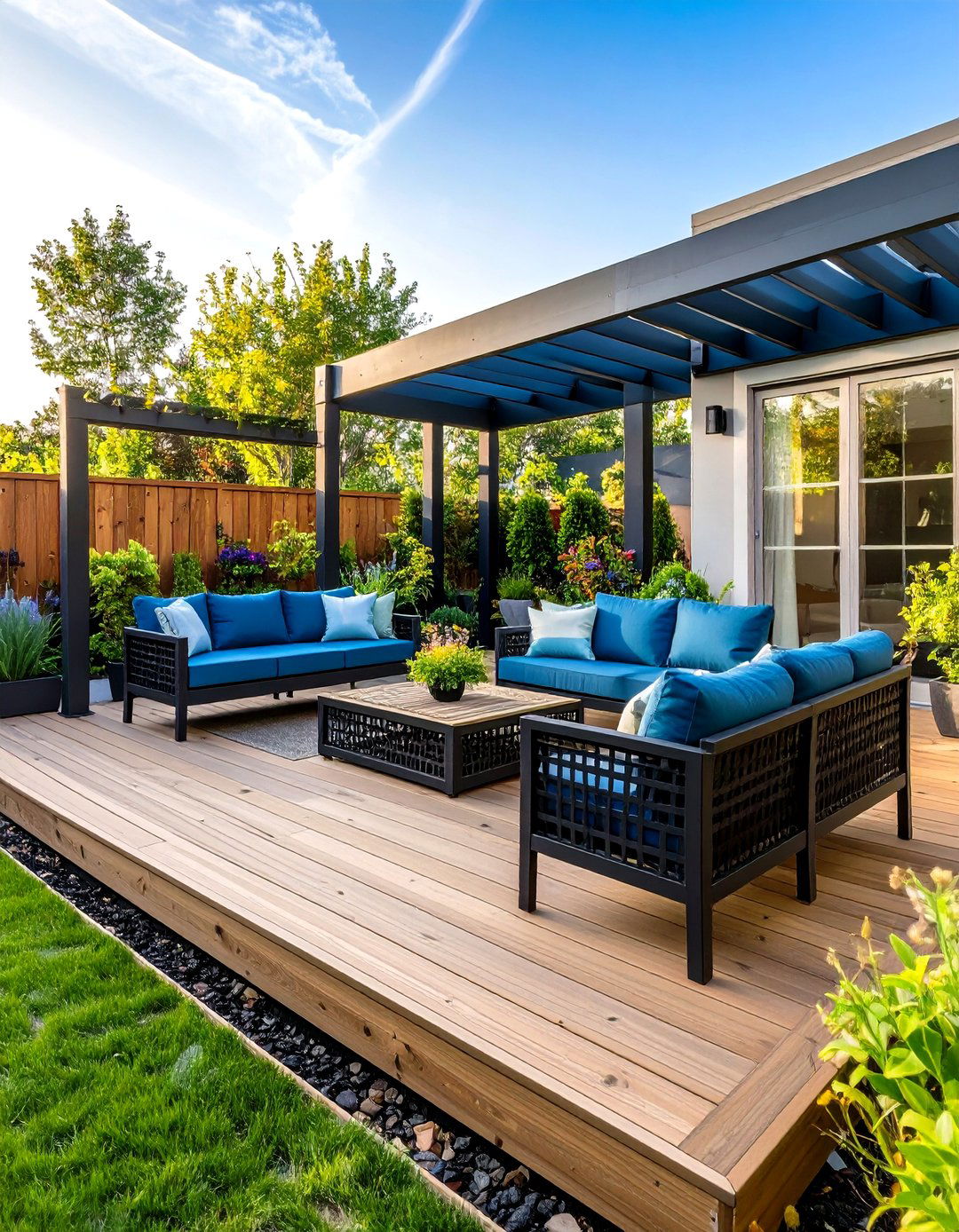
Composite deck lattice panels now arrive prefinished in deep blues, moss greens, or sleek black, letting you echo accent cushions or exterior trim without annual repainting. Advanced polymer-wood mixes resist warping, insects, and UV rays while mimicking the subtle texture of painted wood Trex. Fasten the lightweight panels inside a pressure-treated frame with color-matched screws, and you’ll have a coordinated skirt that can last decades with a quick rinse. Because composite has minimal expansion, you can butt seams tightly for a seamless façade. If local code requires ventilation, drill discreet ½-inch weep holes along lower framing rails to maintain airflow without spoiling the monolithic color field TimberTech.
4. Living-Wall Deck Lattice That Blooms Year-Round

Imagine lattice wrapped in jasmine, clematis, or climbing roses, scenting every sunset. By pairing a sturdy cedar or PVC lattice with drip irrigation and a lightweight soil pocket, you create a vertical garden that doubles as a privacy screen Pretty Handy Girl Architectural Digest. Install 2×4 posts on concrete footings just outside deck framing, then bolt lattice panels to stainless angle brackets so vines can weave freely without stressing deck joists. Use evergreen ivy for winter coverage, interplant annual blooms for seasonal color, and prune regularly to safeguard ventilation gaps. A living lattice also dampens street noise and improves air quality—perfect for urban decks craving a natural buffer.
5. Rugged Aluminum Deck Lattice for Industrial Flair
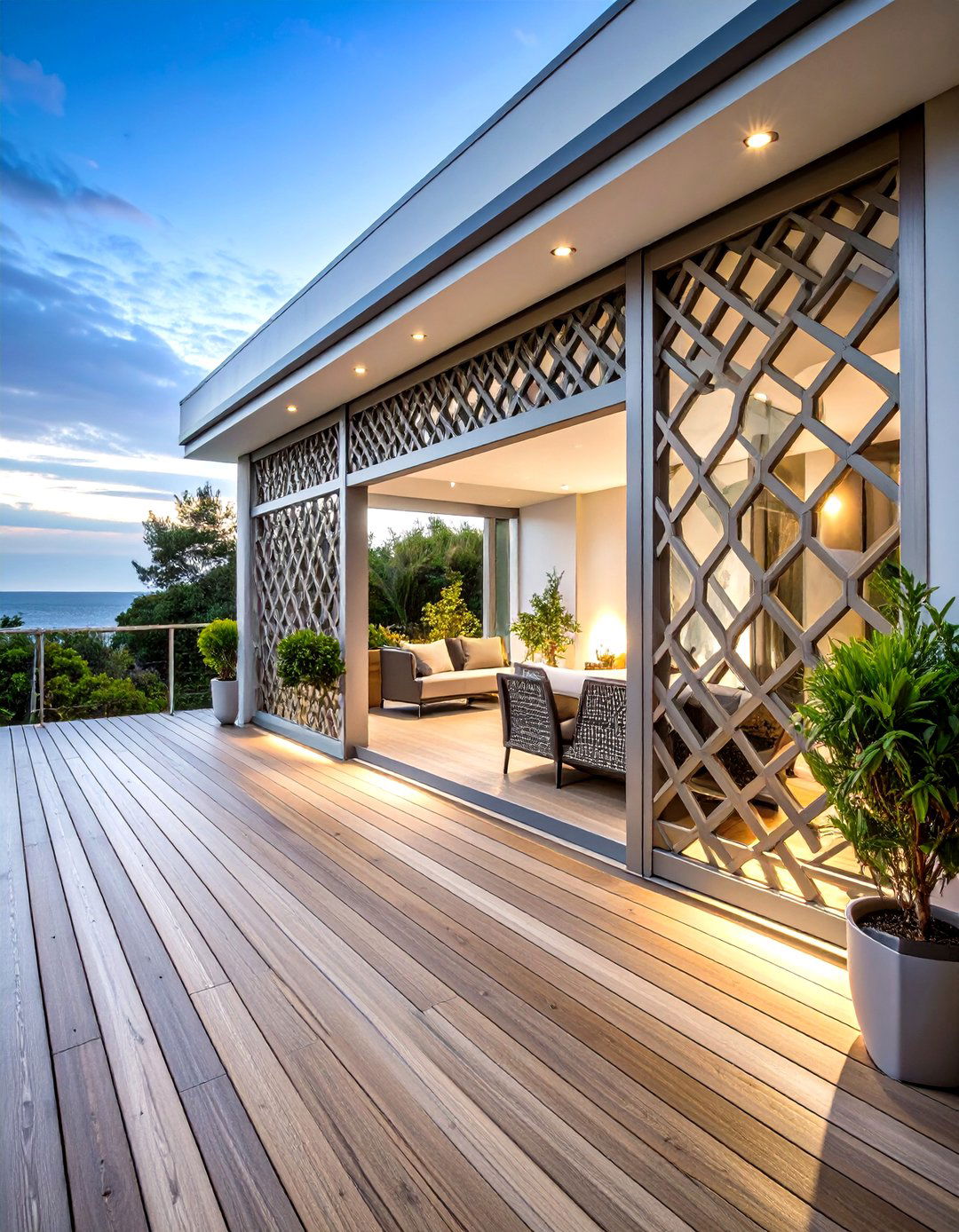
For coastal climates or modern aesthetics, powder-coated aluminum deck lattice offers slim profiles, crisp geometry, and zero rust worries Lowe's. Select black or bronze panels with laser-cut motifs—squares, hexagons, or organic waves—then mount them inside a matching aluminum frame secured to deck posts with self-tapping screws. Because metal panels are self-supporting, you can span wider bays without mid-span blocking, freeing crawlspace access. Their baked-on finish shrugs off salt spray and requires only occasional soap-and-water cleanup. Add LED strip lighting behind the lattice to cast dramatic shadows after dark, reinforcing the industrial vibe while boosting deck safety along stairs and perimeters.
6. Privacy Diamond Deck Lattice for Secluded Lounging
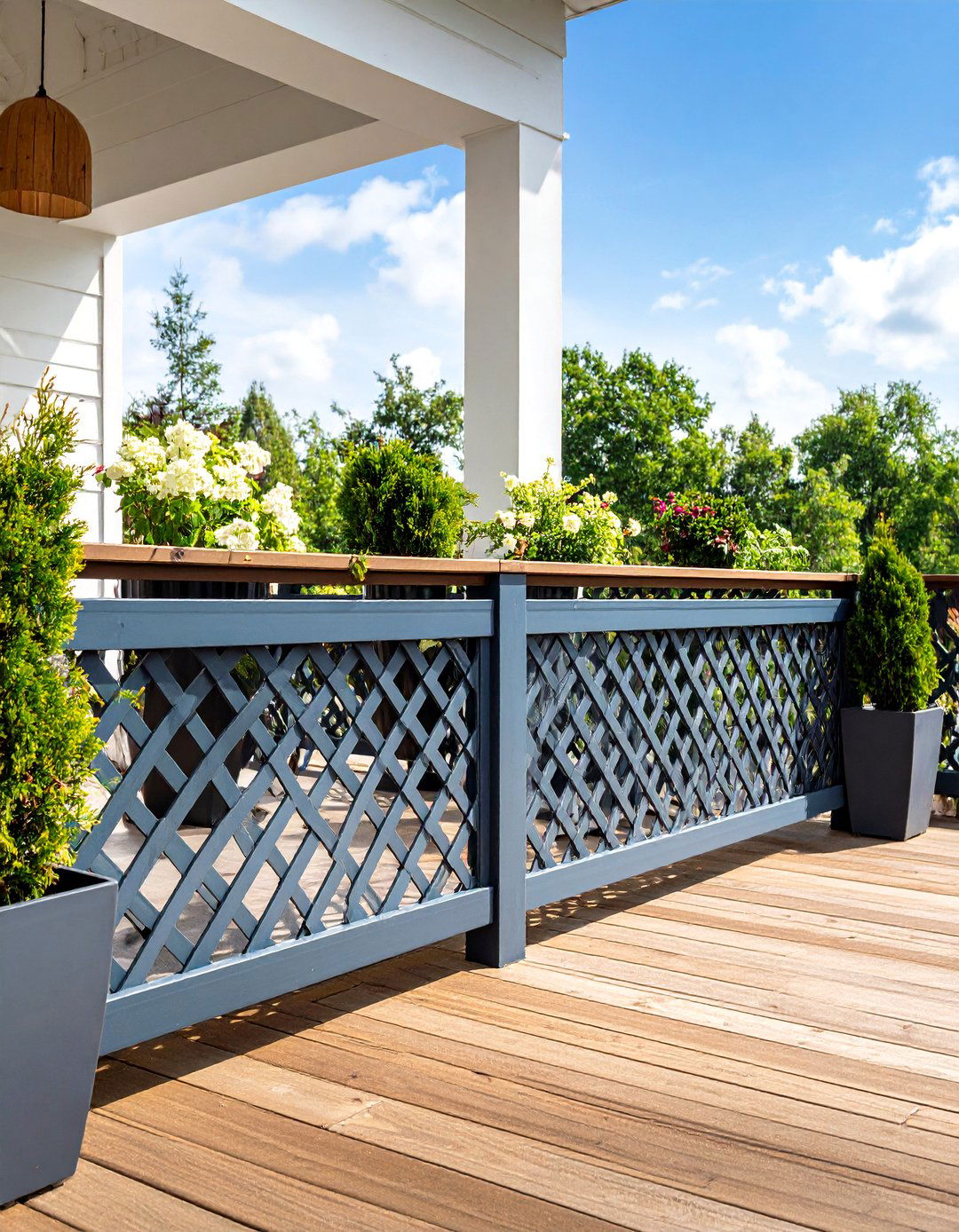
A tight diamond-pattern deck lattice excels at blocking neighbor sightlines while still letting breezes flow. Choose heavy-duty privacy lattice with 1-inch diamonds made of durable plastic or PVC so warping won’t widen gaps over time Deck Expressions. Frame panels inside 2×4 rails, angle the diamonds 45 degrees to the joists for design contrast, and finish edges with cap molding to hide raw cuts. If your deck doubles as a hot-tub zone, the denser pattern helps contain steam while screening pumps and plumbing. Paint or stain the frame to match deck rails, and plant dwarf evergreens in tall planters for an extra layer of green privacy in front.
7. Shadowbox Double-Layer Deck Lattice for Visual Depth
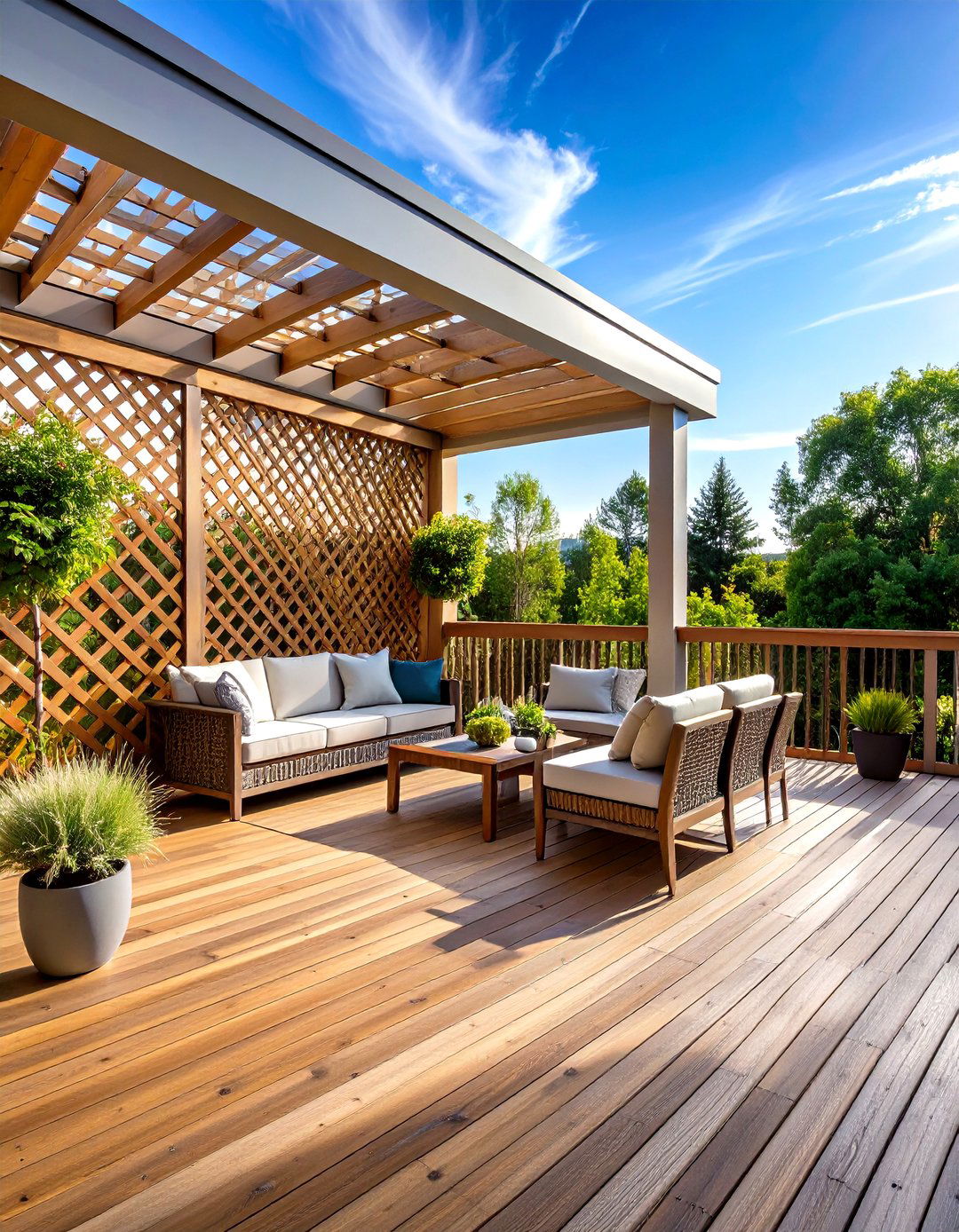
Stacking two lattice layers—offset so openings cross halfway—creates a sophisticated shadowbox effect that looks handcrafted. Start with a base panel of ¾-inch cedar diagonal lattice, then top it with a finer PVC square grid using ½-inch spacers at corners. The interplay of light and shadow gives your deck lattice unusual depth, masking under-deck clutter even more effectively than single panels DeckGuru. Because airflow remains, you avoid the moisture buildup problems of solid skirting. Tie both layers into a single treated-lumber frame and anchor that frame with concealed angle brackets for a floating, art-panel appearance that elevates traditional decks into gallery territory.
8. Sliding Deck Lattice Panels for Easy Storage Access
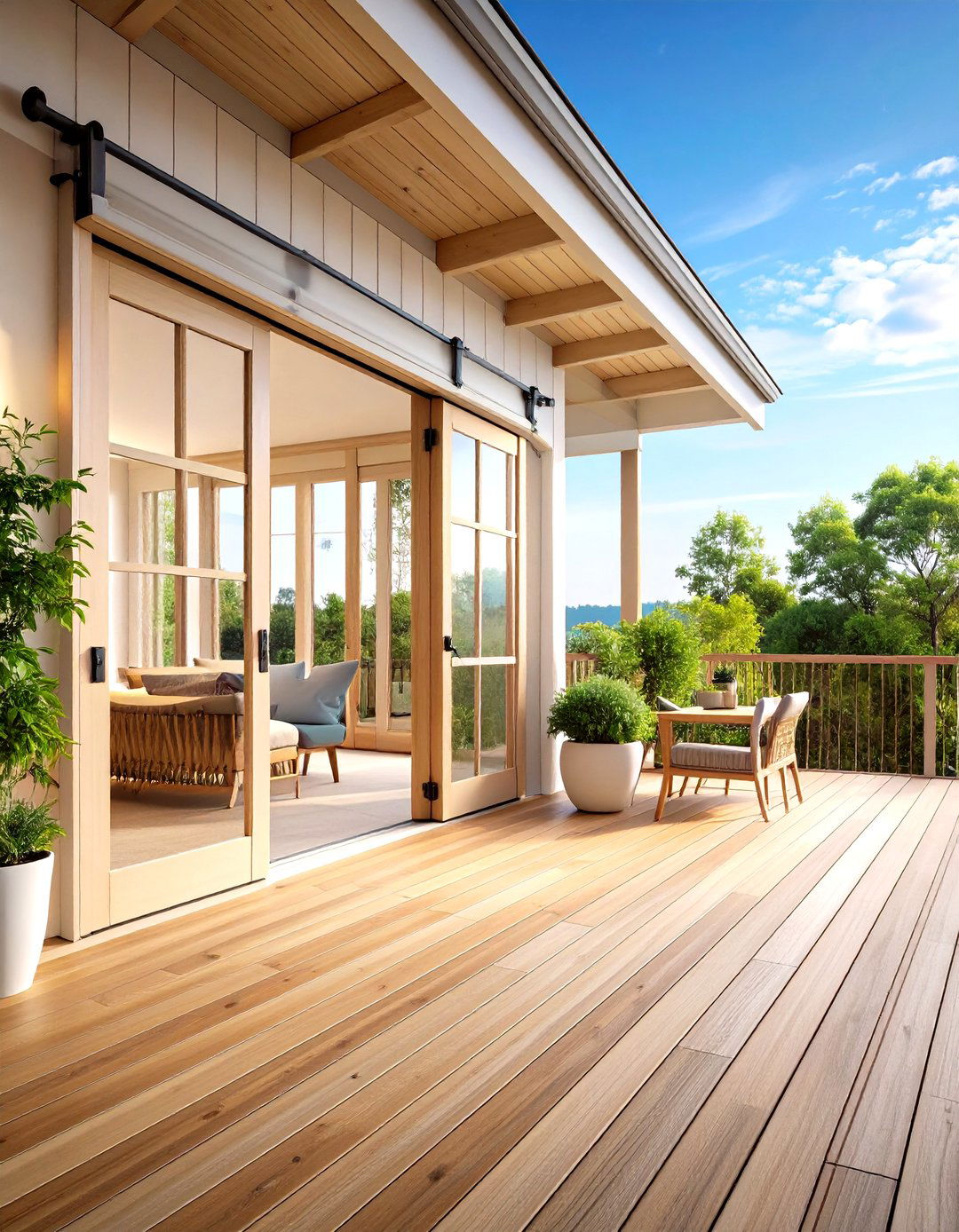
Gain instant access to lawn-equipment storage by mounting deck lattice panels on stainless barn-door tracks. Choose composite or PVC lattice so weight stays manageable, then lag the track to rim joists and attach rolling hangers to the lattice frame. A foot-operated latch keeps panels secure in high winds. This sliding approach, popular among DIY installers looking to maximize crawlspace use, appears in several “alternatives to lattice” guides but remains under-adopted despite its practicality Trex Rain Escape This Old House. Finish the panel in deck-matching stain and add a discreet finger pull. You’ll no longer wrestle with screwdrivers every time you need the garden hose or patio chairs.
9. Bench-Back Deck Lattice for Dual-Purpose Seating
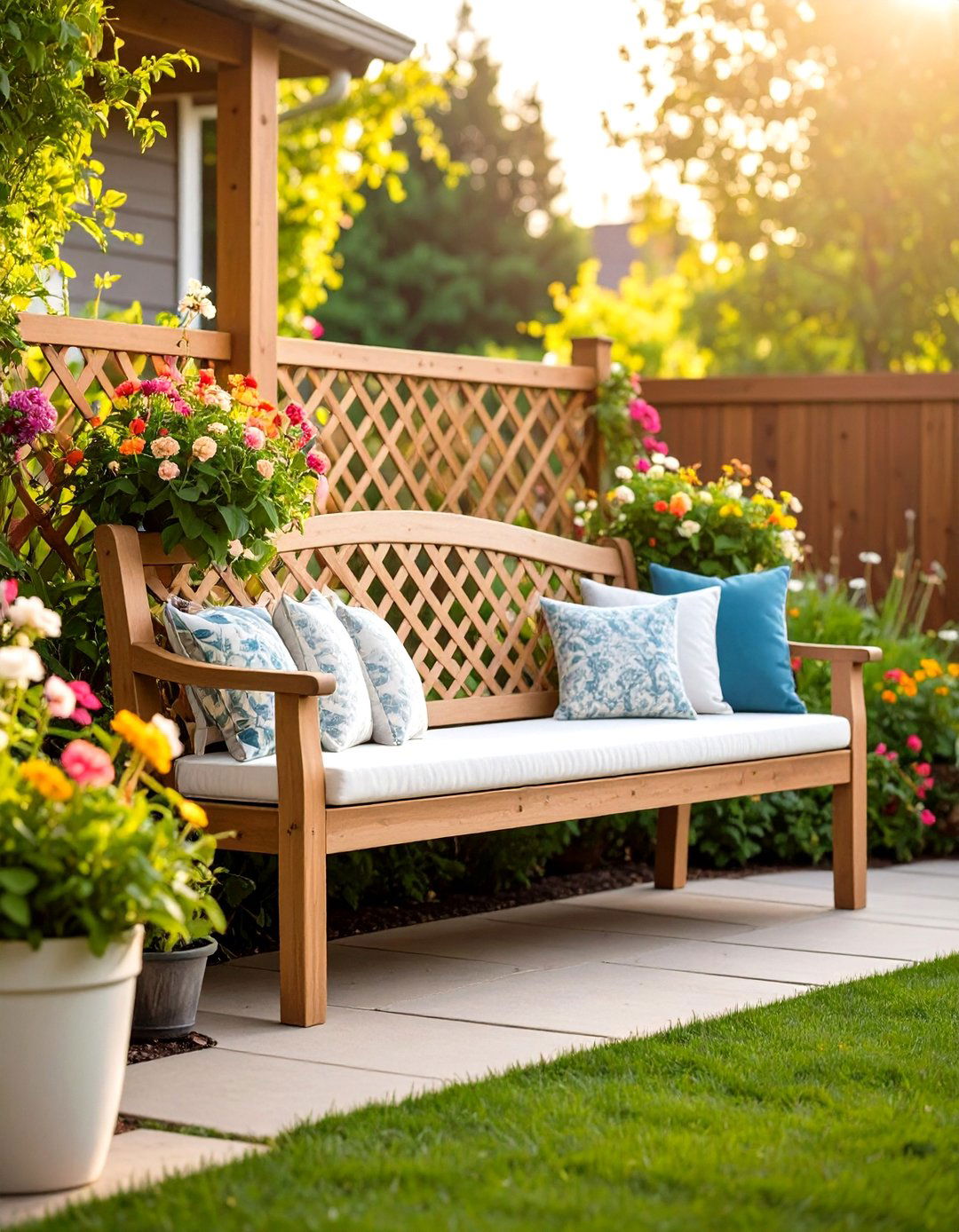
Combine seating and screening by building a 24-inch-high planter bench backed by four-foot lattice panels. Lag 2×6 bench supports between deck posts, clad faces in horizontal decking off-cuts, then fasten lattice above the bench to create a sheltered nook. This arrangement channels prevailing breezes upward, reducing wind chill while giving you a cozy lounging wall The Deck Store. Top rail lights or string lights weave easily through the lattice, and the bench cavity can double as hidden storage via lift-up seat lids. Finish everything in the same stain to tie the unit together and make your deck lattice feel purpose-built rather than tacked on.
10. Solar-Lit Deck Lattice Posts for Eco-Friendly Ambiance
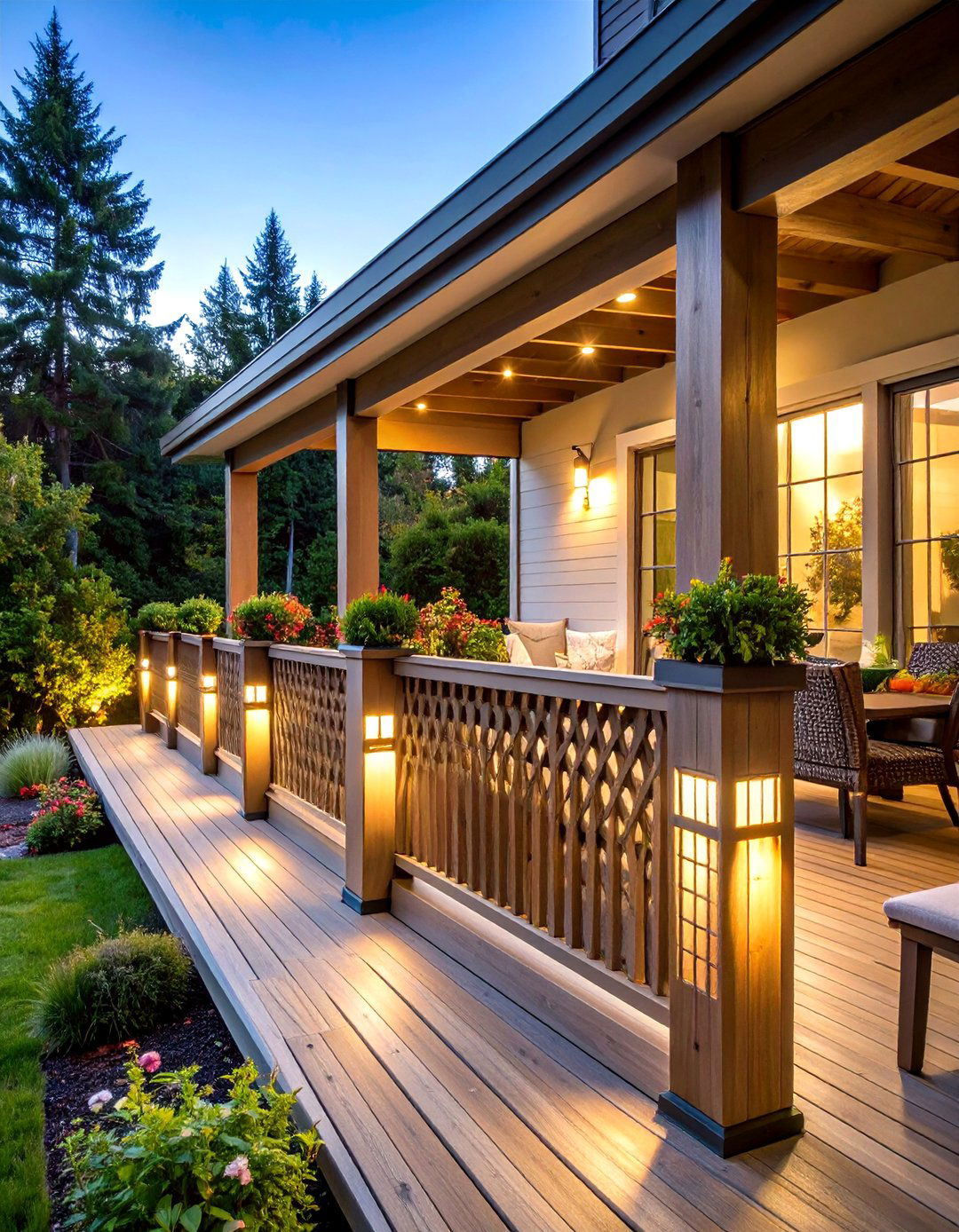
Upgrade lattice corners with solar post-cap lights that bathe the grid in a soft evening glow powered entirely by the sun Deck Expressions Trex. Modern caps fit 4×4 or 6×6 sleeves and deliver 7–15 lumens—enough to highlight texture without glare. Because wiring isn’t required, you can retrofit caps after lattice installation; just slip them over posts, press the on/off button once, and let dusk sensors do the rest. Choose black or bronze housings to disappear against dark lattice frames, or clear lenses to throw patterned light through open diamonds. A simple solar upgrade turns a daytime privacy element into nighttime décor and improves edge visibility for guests.
11. Painted-Mural Deck Lattice for Artistic Flair
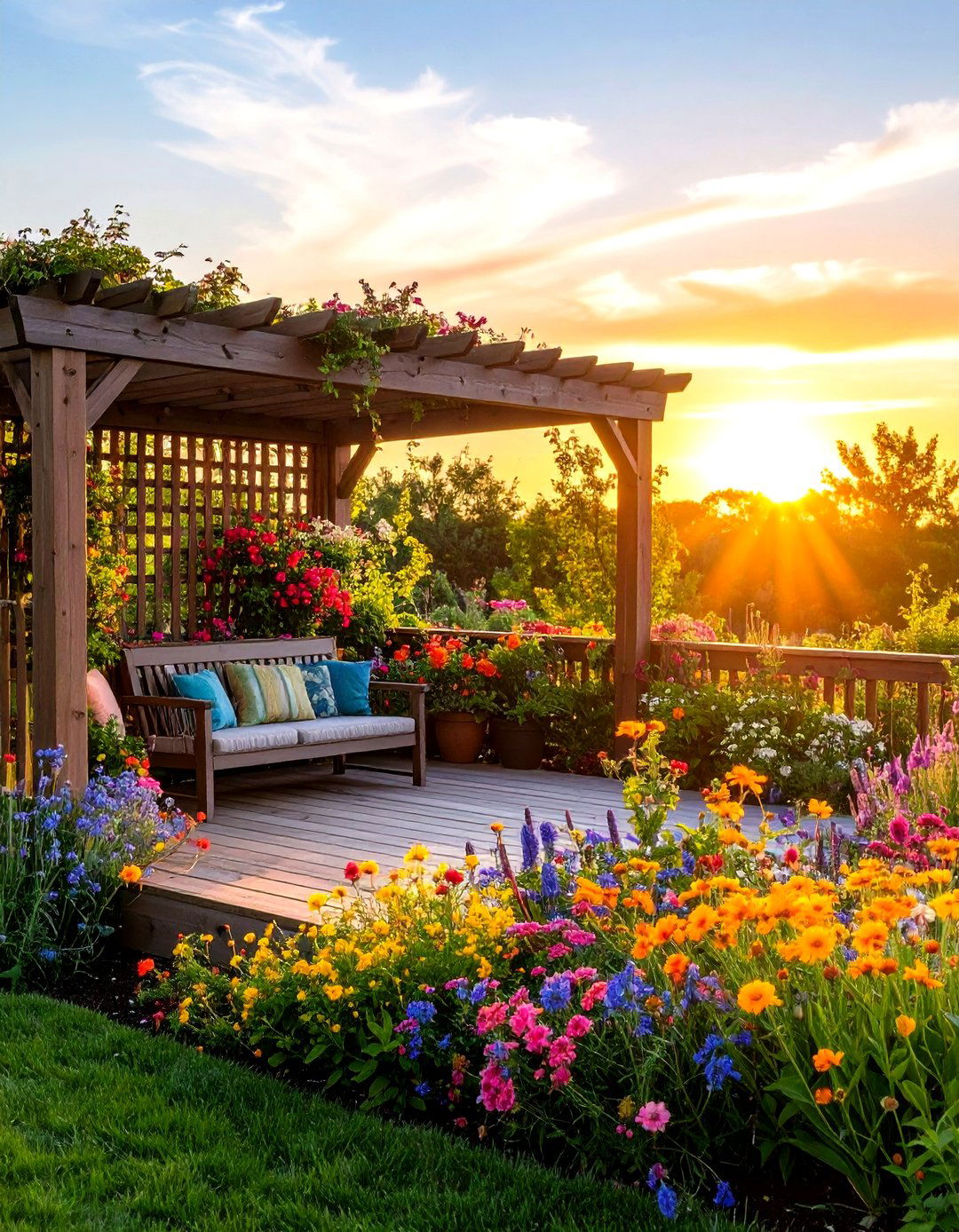
Turn plain lattice into outdoor art by painting an ombré sunset or botanical motif across several joined panels before installation. Water-based exterior paints adhere well to primed wood or PVC lattice and resist UV fading when topped with a clear, non-yellowing sealer. DIY galleries show countless examples of painted lattice transforming basic decks into vibrant backdrops for container gardens Pinterest. Sketch your design with chalk, block in main colors using a roller, and finish details with artist brushes. Because the pattern remains semi-open, ventilation and code compliance stay intact. A mural lattice personalizes rental spaces too, as panels can be removed at move-out with zero wall damage.
12. Pergola-Extension Deck Lattice Overhead

Extend your deck lattice vertically by capping rail posts with a slim pergola frame and running lattice across the top to filter harsh sun. Attaching 2×2 cedar rafters then nailing lightweight vinyl lattice sheets above creates dappled shade ideal for midday lounging—and climbing plants will happily take the invite Architectural Digest The Deck Store. Secure lattice to rafters with stainless staples, and leave ¼-inch expansion gaps every four feet to prevent buckling. Because the overhead panels sit higher than rail height, they don’t block views when seated but still offer UV protection. Add string lights above for a starlit canopy effect after dark.
13. Curved Deck Lattice Skirt for Elevated Platforms
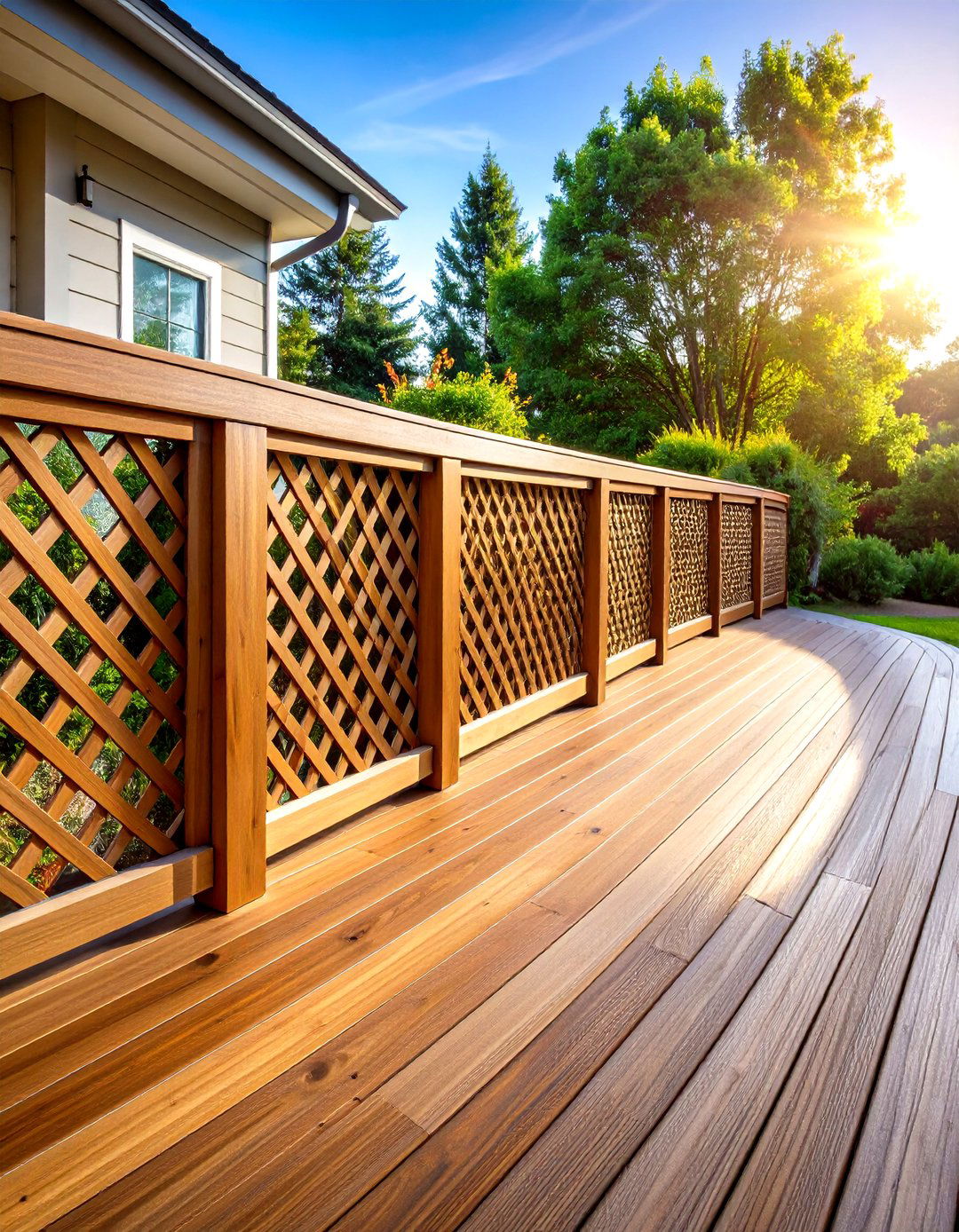
If your deck perimeter follows a gentle curve, consider steam-bending thin cedar or cellular-PVC lattice into shape rather than cutting faceted straight sections. Flexible lattice brands advertise bend radii down to 24 inches without cracking, perfect for rounded corners on spa decks or wraparound porches. Build a curved bottom rail from laminated plywood ribs, then staple lattice to ribs and top rail, trimming ends flush. A continuous curve eliminates the shadow lines and dirt-collecting gaps that form between straight panels on a radius, giving your deck lattice a custom-carpenter finish while still permitting crawlspace airflow Trex Rain Escape.
14. Mixed-Material Deck Lattice with Cable-Rail Accents
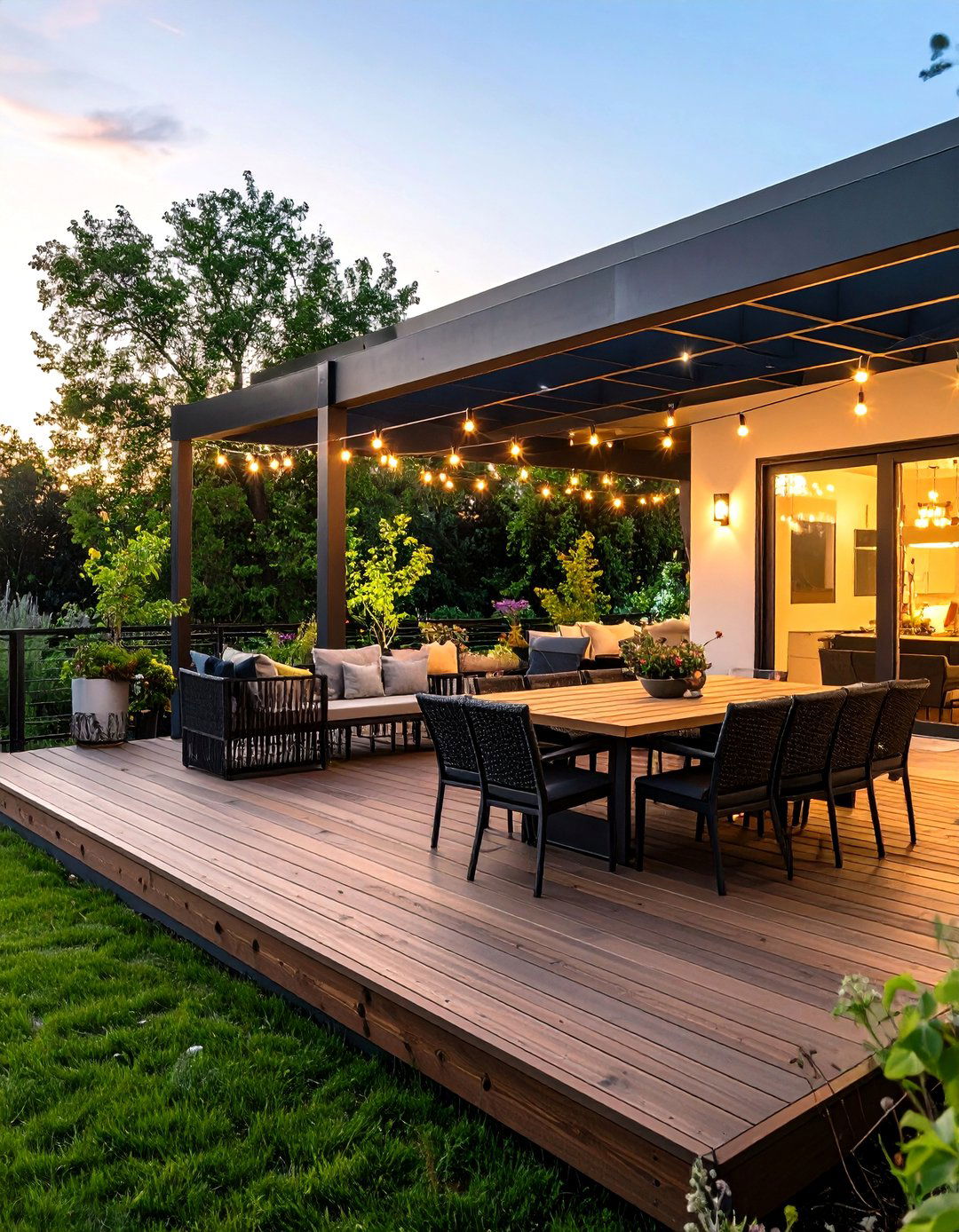
Blend industrial and organic textures by infilling lower deck bays with cedar lattice while running stainless-steel cables horizontally above. The lattice grounds the design and hides storage, while cables keep sightlines open toward the view. Trend reports highlight mixed-material skirts as a 2025 favorite, especially when lattice and cable share a bold dark stain for cohesion DeckGuru Elgin Ildeck Contractors. Use tensioners anchored into 4×4 posts, spacing cables every 5 inches per most guardrail codes, and cap posts with powder-coated aluminum. The resulting composition feels airy yet secure, perfect for modern lake-house decks looking to bridge rustic and sleek aesthetics.
15. Planter-Box Wrap Deck Lattice for Instant Greenery
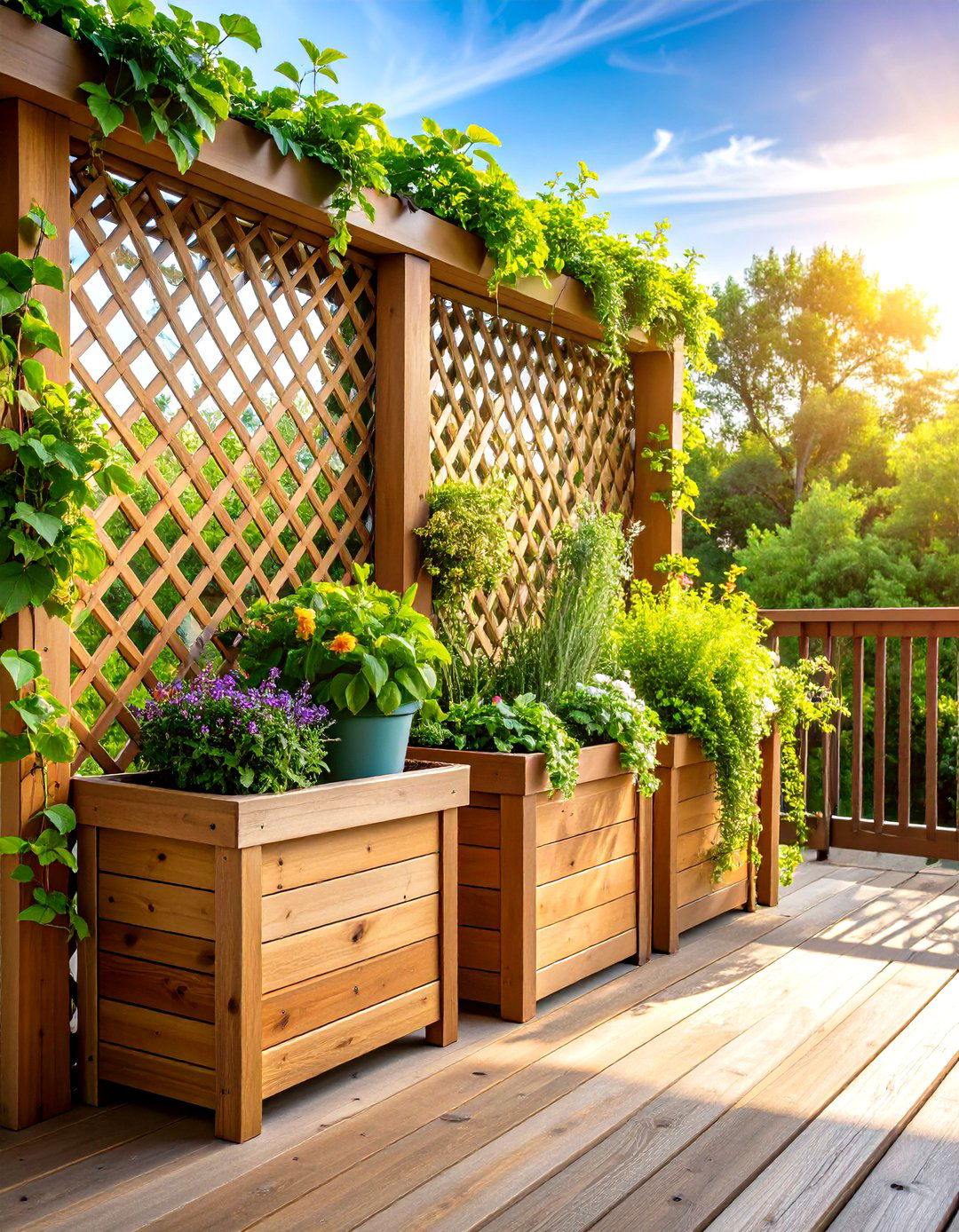
Surround raised planter boxes with mini lattice screens to let vines cascade down, softening wood lines and disguising soil edges. Build 18-inch-tall planters from 1×8 cedar, screw ¾-inch square lattice directly to planter sides, and attach the assembly to deck framing so boards don’t trap moisture against planks. Climbing veggies like beans or flowering sweet peas race up the lattice, adding color and snack potential by midsummer The Deck Store The Spruce. Because planters sit atop the deck, you avoid digging footings yet still gain lush privacy where rail pickets alone fall short. Drainage holes drilled through the planter bottom keep roots healthy.
16. Modular PVC Deck Lattice with Hidden Fasteners
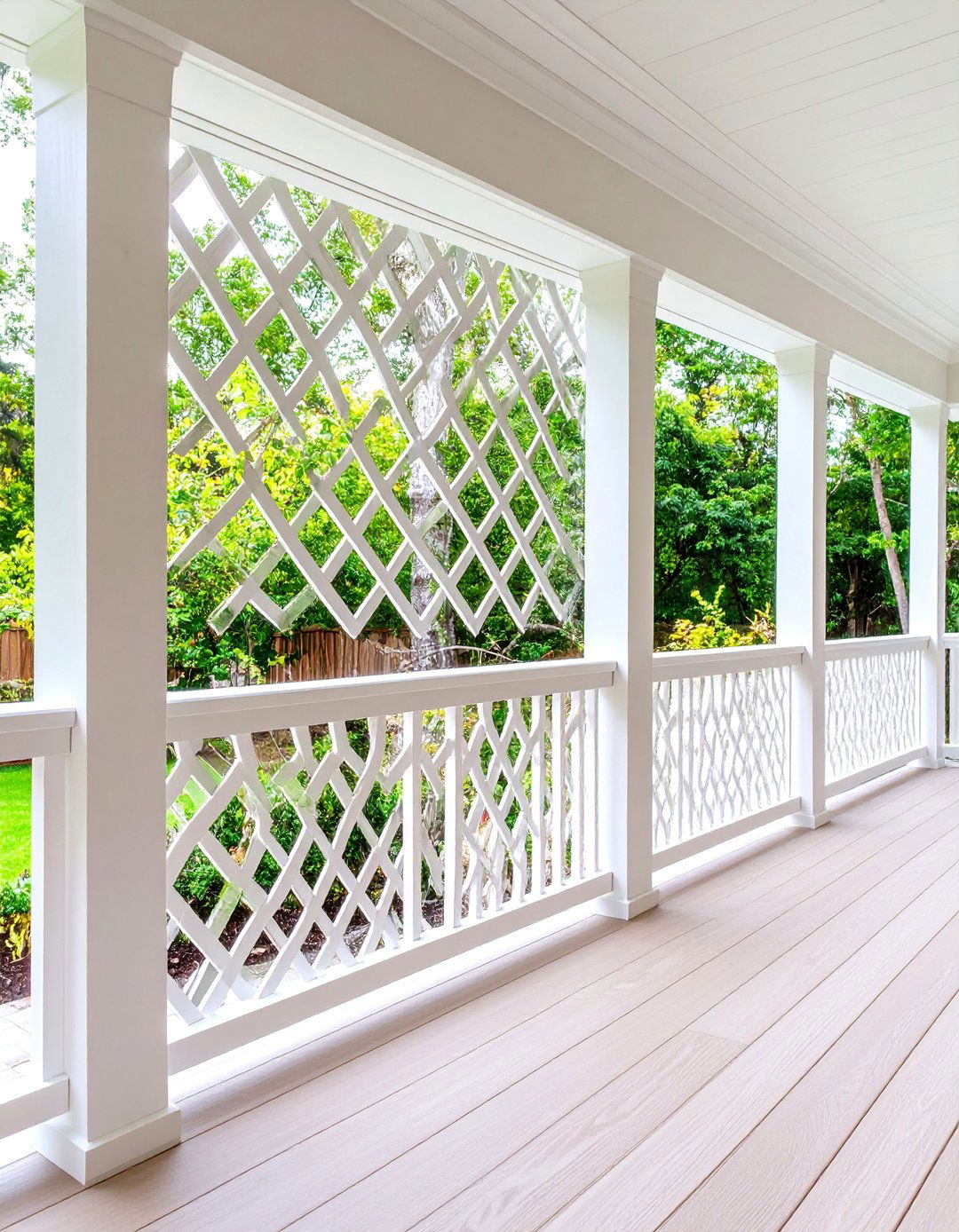
PVC deck lattice panels now ship with matching cap and divider molding kits that snap together, hiding screws and giving seams a mill-finished look The Home Depot Lowe's. Each 24×96-inch sheet can be trimmed with a fine-tooth blade, then slotted into the molding—no pilot holes needed. Because PVC resists moisture and insects, it’s ideal for low-clearance decks where airflow is limited. Keep panels bright white for a traditional porch vibe or spray with exterior-grade vinyl paint to match colored railing. Should a panel crack (rare but possible after heavy impact), unlatch the molding, swap in a new piece, and click everything back in place in minutes.
17. Reclaimed-Wood Deck Lattice for Rustic Warmth
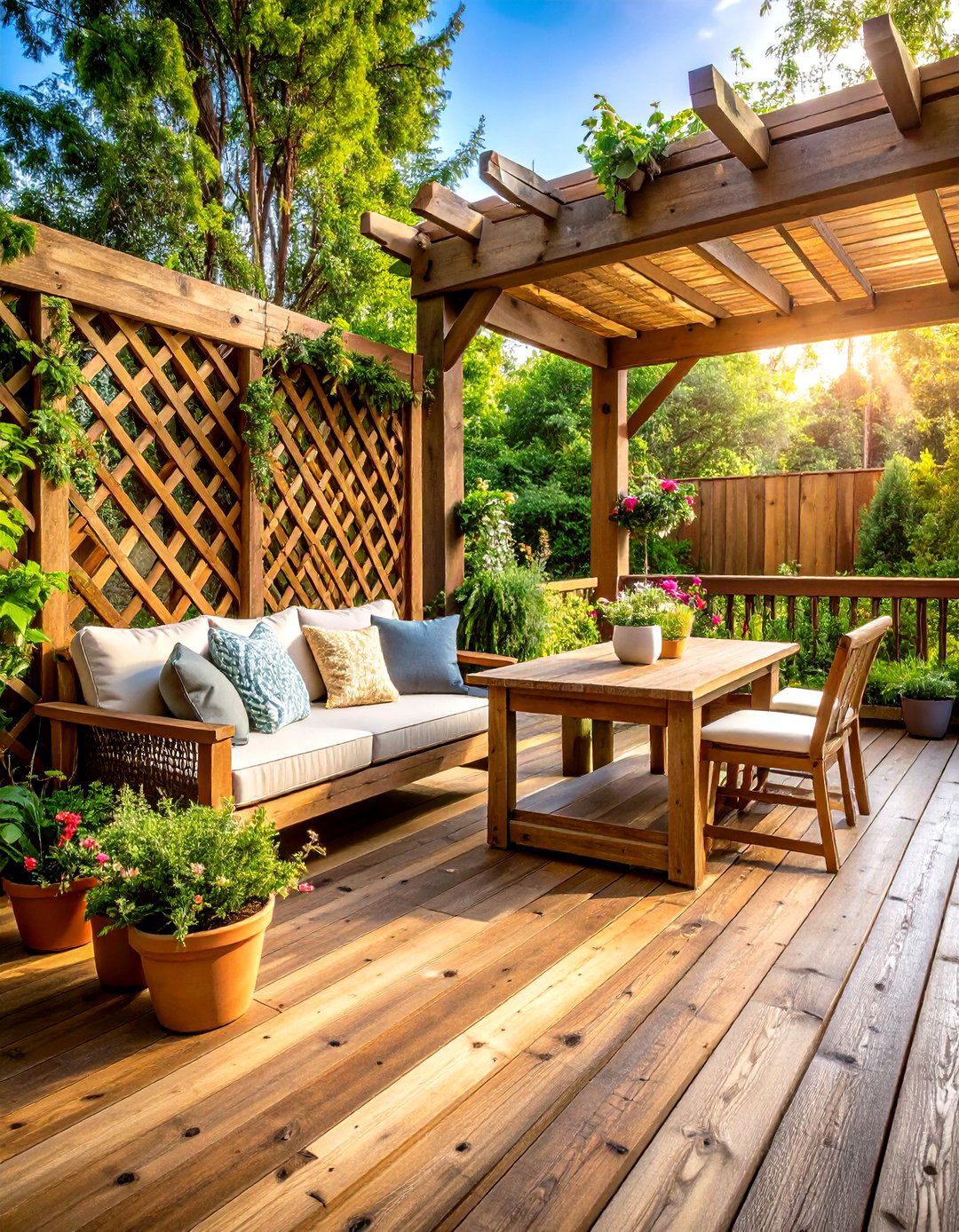
Salvaged fence boards or pallet slats cut into 1×2 strips can be woven into a rough-hewn lattice that oozes farmhouse charisma while recycling timber. Sand boards lightly to remove splinters yet keep saw marks for character, then treat with a clear outdoor oil to highlight patina. Rustic lattice pairs especially well with stone fire-pit patios and galvanized-metal planters, key elements called out in 2025 skirting-style guides DeckGuru. Use structural screws and backer frames to compensate for irregular lumber thickness, and add a hardware-cloth layer behind the weave if you need extra pest control without spoiling the weathered look.
18. Insulated Deck Lattice Panels for Four-Season Comfort
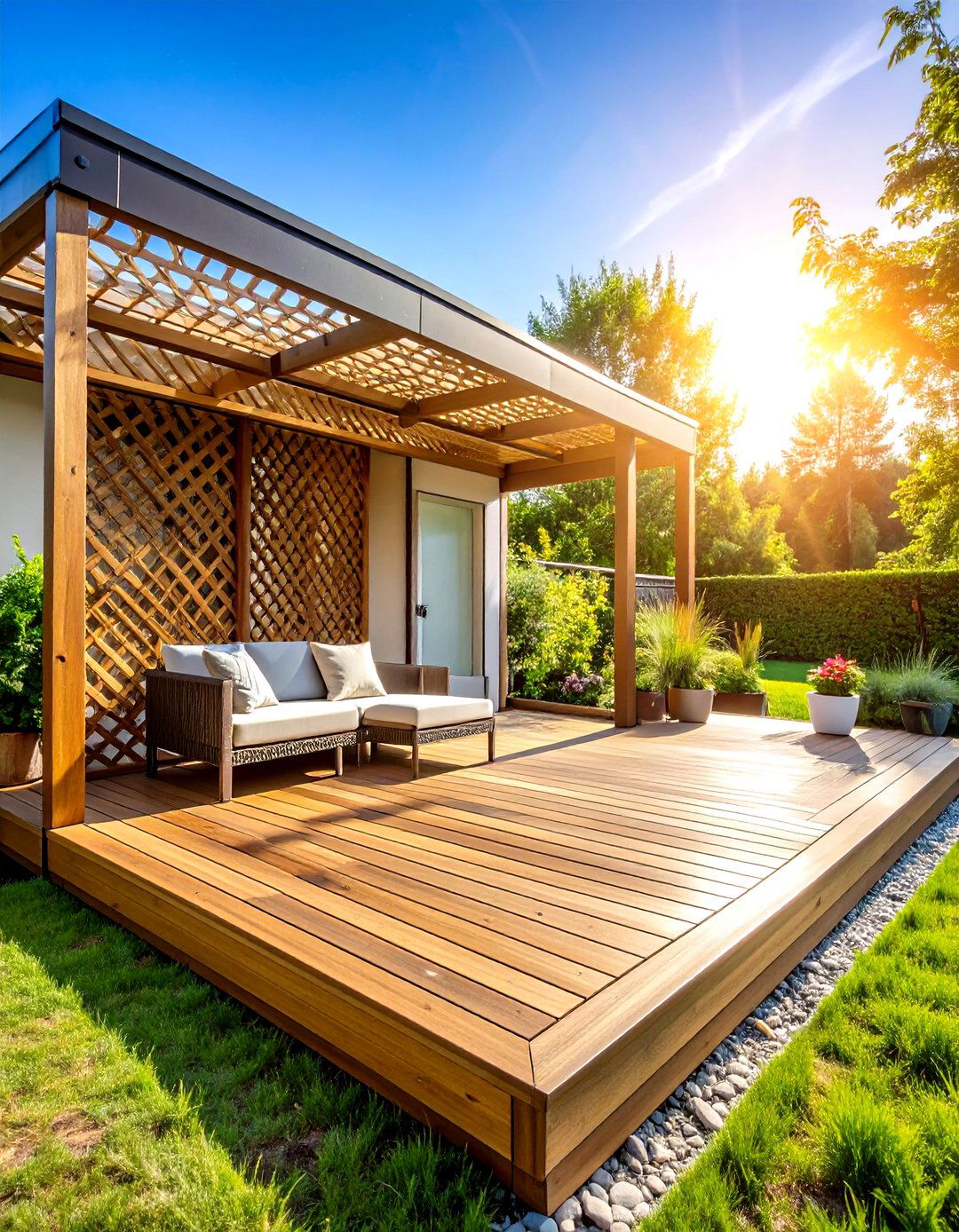
When your deck shelters a finished basement or temperature-sensitive storage, rigid-foam-backed lattice panels create a thermal break while maintaining ventilation through offset vent slots. Install treated 2×4 framing on joist bottoms to house 1-inch foam, then attach lattice over that sandwich with furring strips. Building-code best practices recommend continuous airflow above insulation to prevent condensation, so leave a ½-inch gap at top and bottom of panels and cover with mesh to block pests TimberTech. Paint furring to match lattice, and you’ll gain energy savings while keeping your deck’s exterior rhythm intact.
19. Hinged Door Deck Lattice Panels for Utility Access
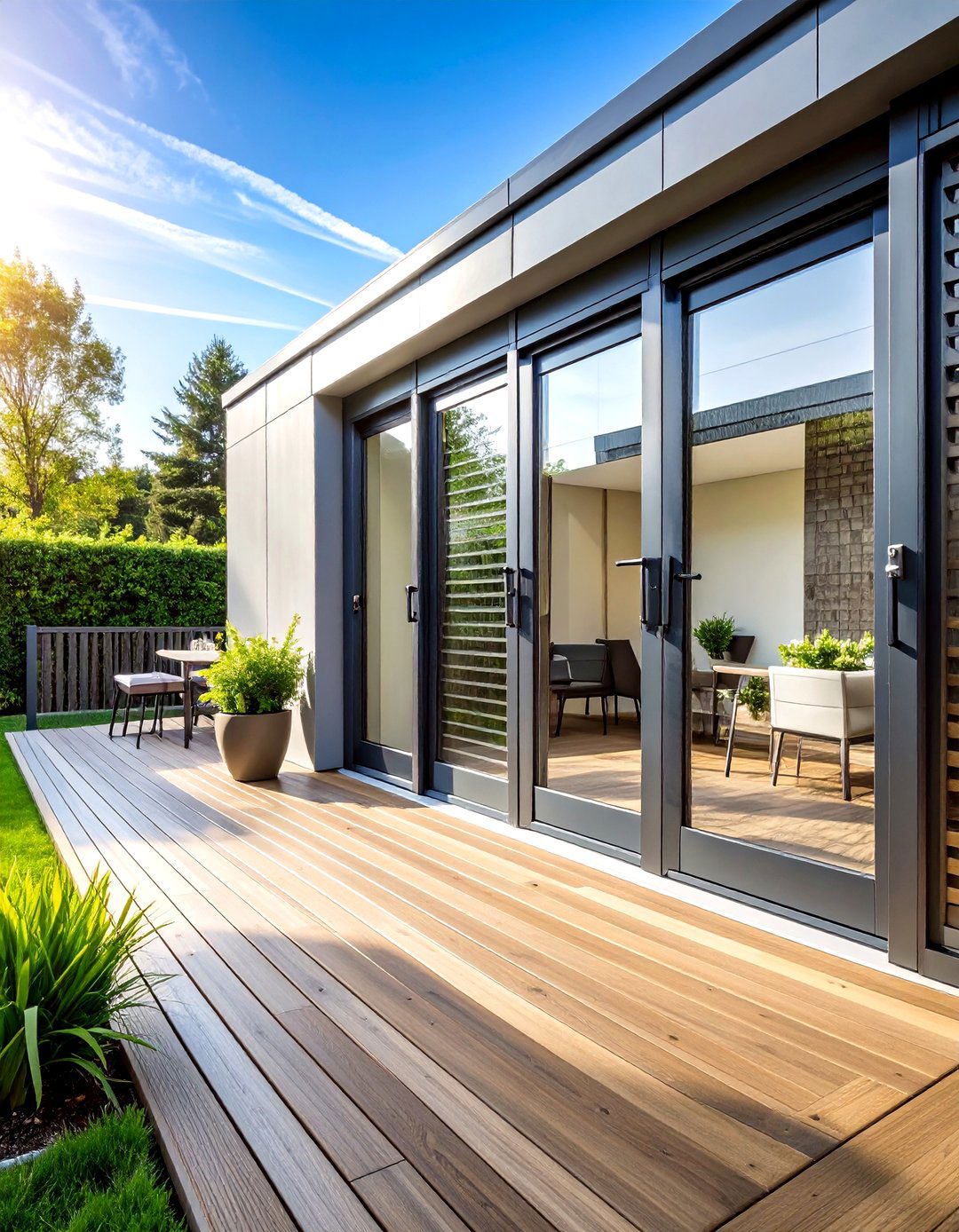
Incorporate full-height hinged doors into your deck lattice to simplify tasks like changing propane tanks or accessing plumbing cleanouts. Frame a 32-inch opening with doubled 2×4 studs, hang a lattice-skinned door on stainless butt hinges, and add a magnetic latch hidden behind trim so the facade stays flush. Retrofit how-to guides emphasize pre-drilling PVC lattice for hinges to avoid cracks This Old House Trex Rain Escape. Finish door edges with cap molding, and mark the latch spot subtly with a tiny recessed pull. With utility access solved, you can commit to a tighter, more attractive lattice pattern elsewhere without fear of future headaches.
20. Frameless Floating Deck Lattice Screen for Minimalist Decks
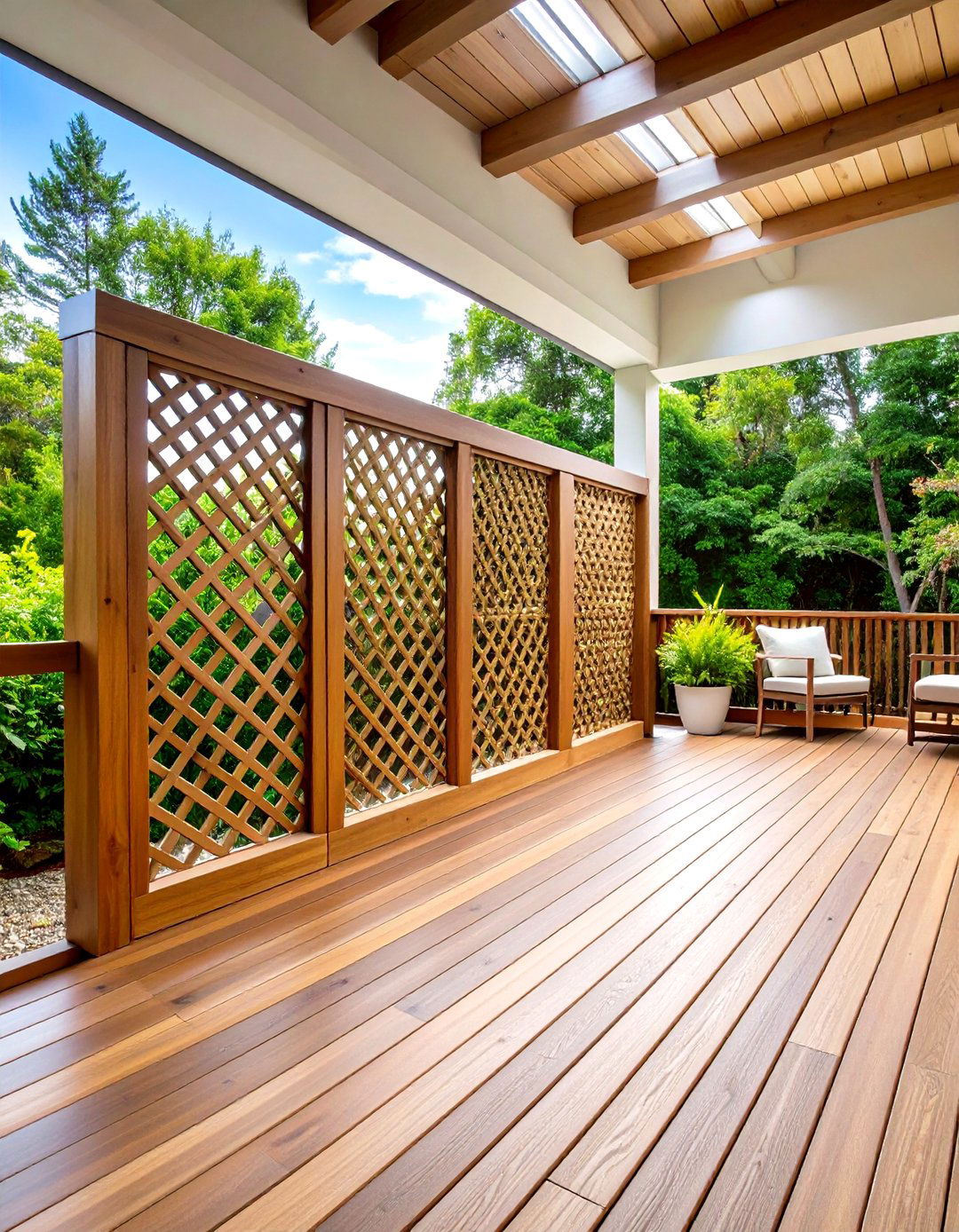
Skip visible framing altogether by mounting composite lattice inside routed grooves on the back faces of deck rim boards, letting the grid appear to float. This detail, seen in cutting-edge minimalist decks, uses metal spline clips that lock lattice edges flush with rim boards for an ultra-clean profile Elgin Ildeck Contractors. Because the lattice sits slightly recessed, shadows outline the grid and add depth without protruding frames. Maintain at least a ¾-inch drainage gap behind the lattice to meet ventilation guidelines, and attach removable corner clips so panels can slide out for seasonal clean-ups. The result is a deck lattice that reads more like modern art than utilitarian skirting.
Conclusion:
Whether you lean toward lush living walls, industrial aluminum grids, or vintage reclaimed-wood weaves, today’s deck lattice choices let you dial in privacy, ventilation, style, and code compliance with equal ease. By mixing materials, integrating lighting, or adding movable panels, your deck lattice becomes a multifunctional feature that protects structure, masks clutter, and sets a distinctive design tone. Embrace the idea that a lattice skirt is more than a cosmetic afterthought—it’s the finishing stroke that turns any deck into a cohesive, year-round outdoor sanctuary.


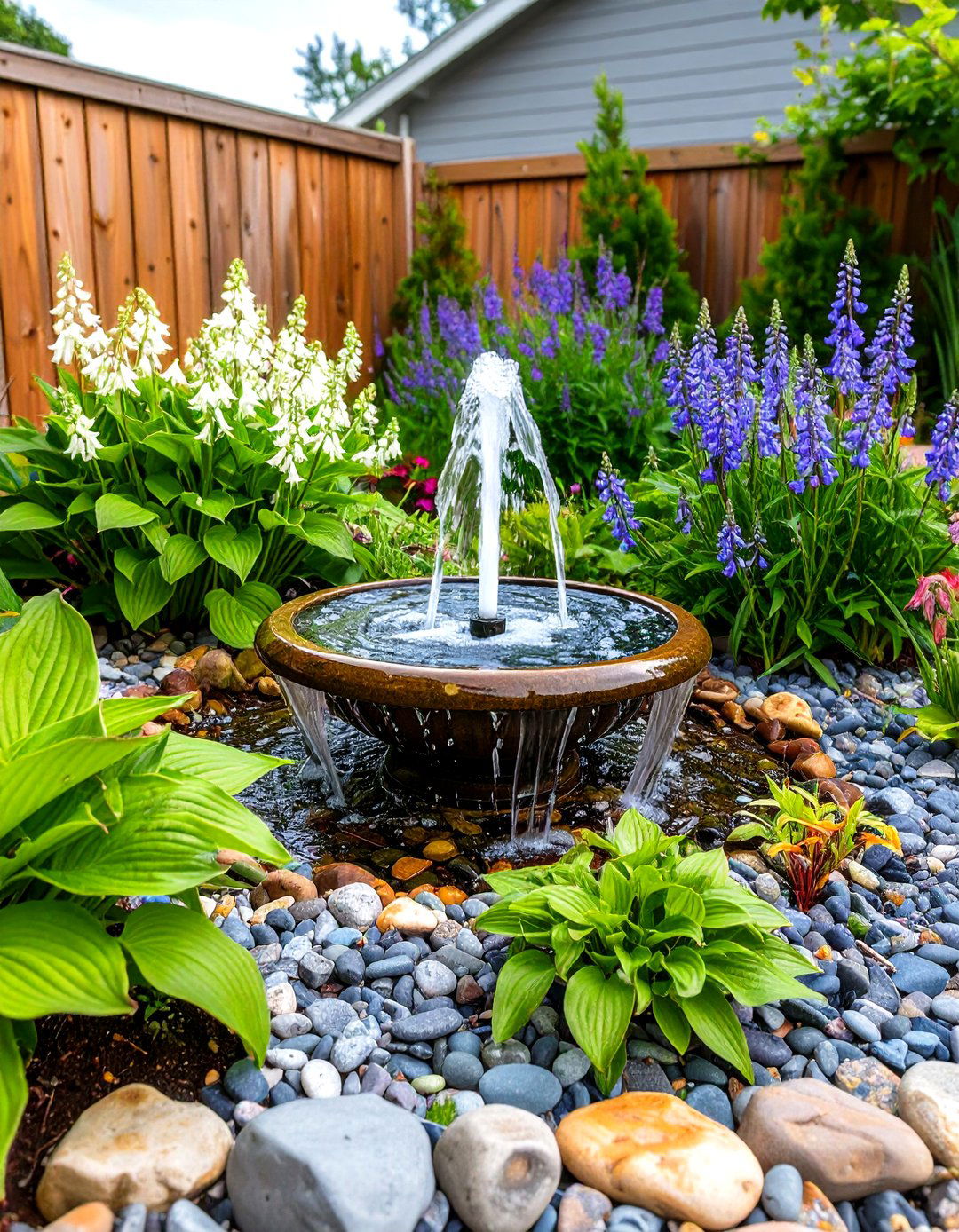
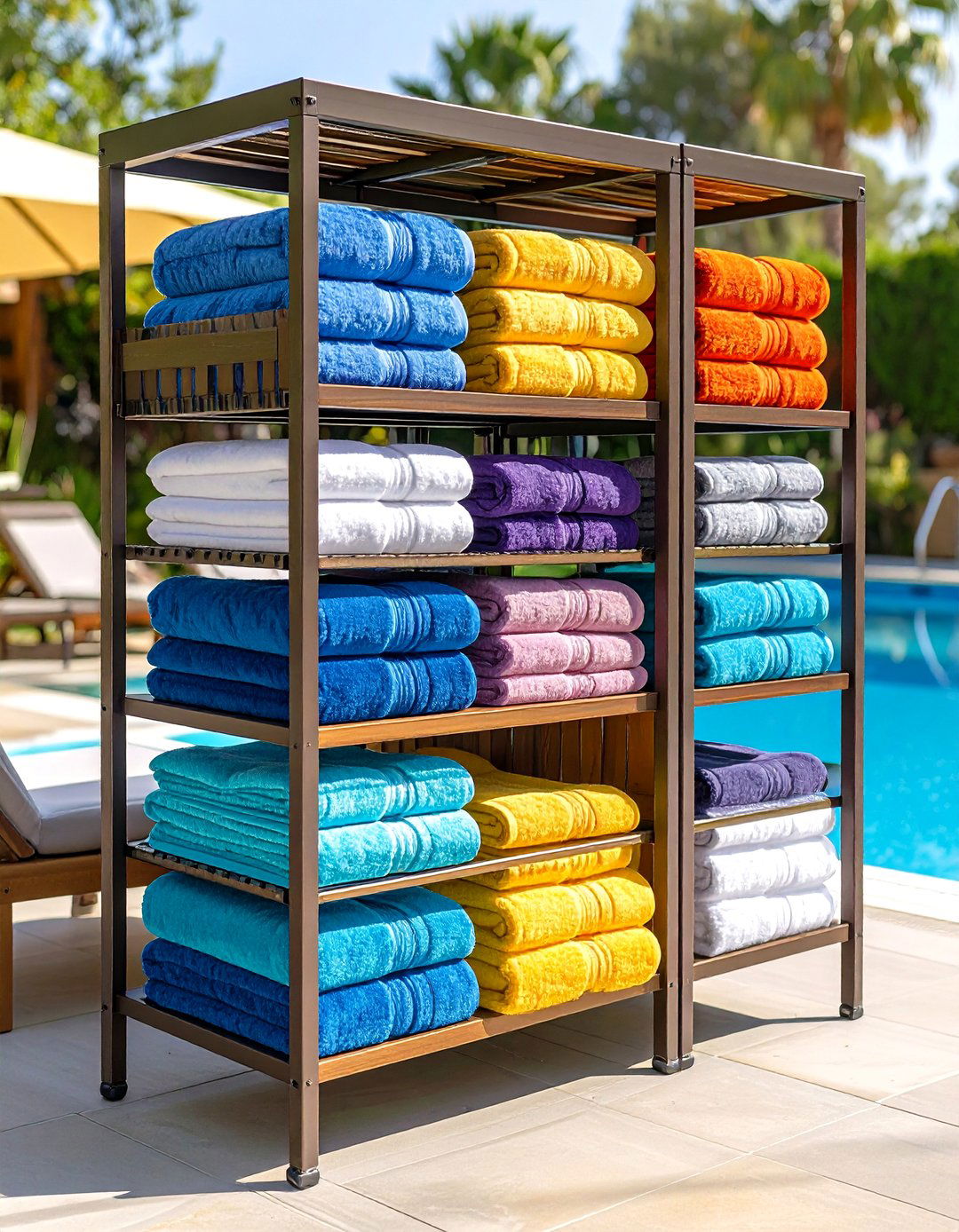


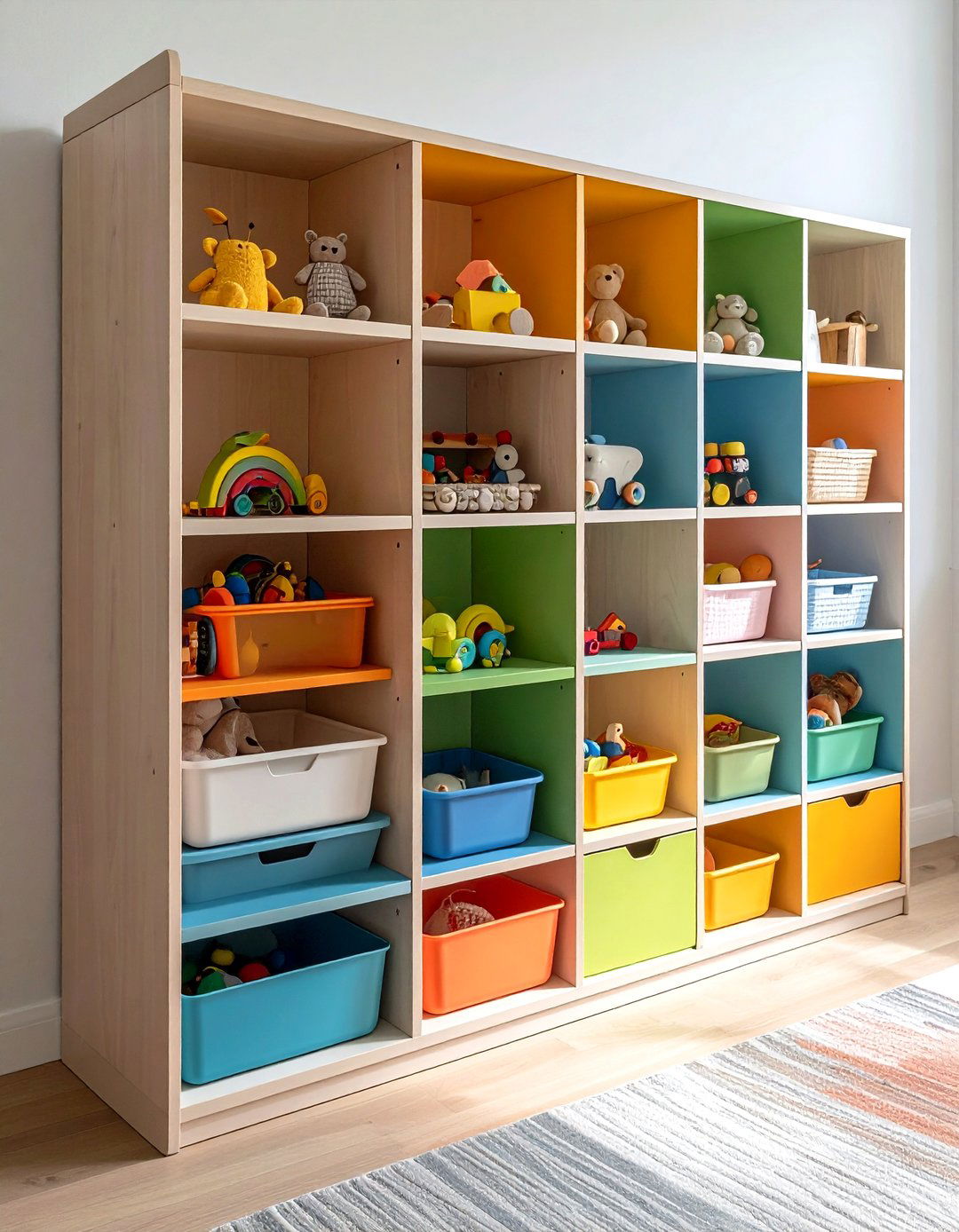


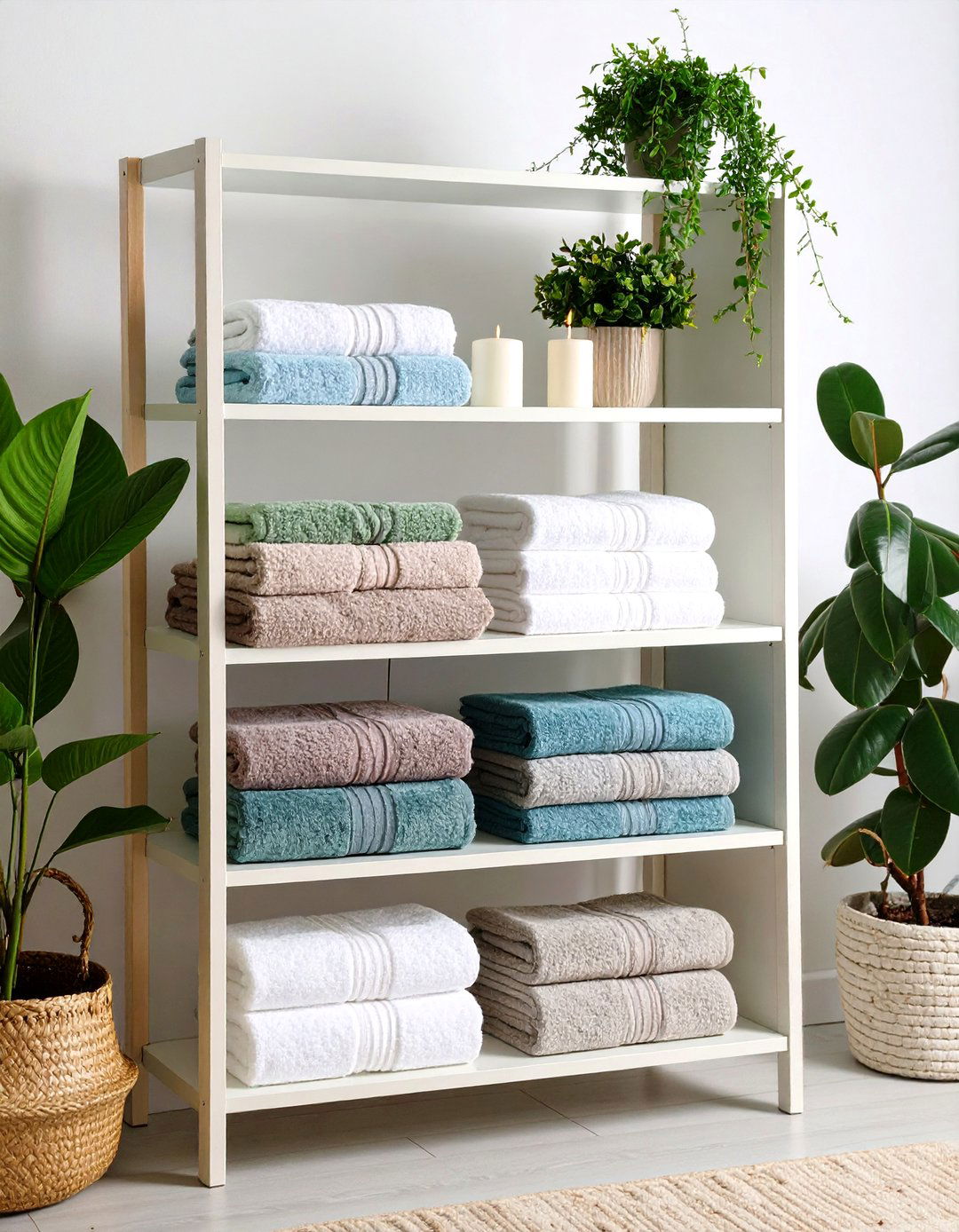
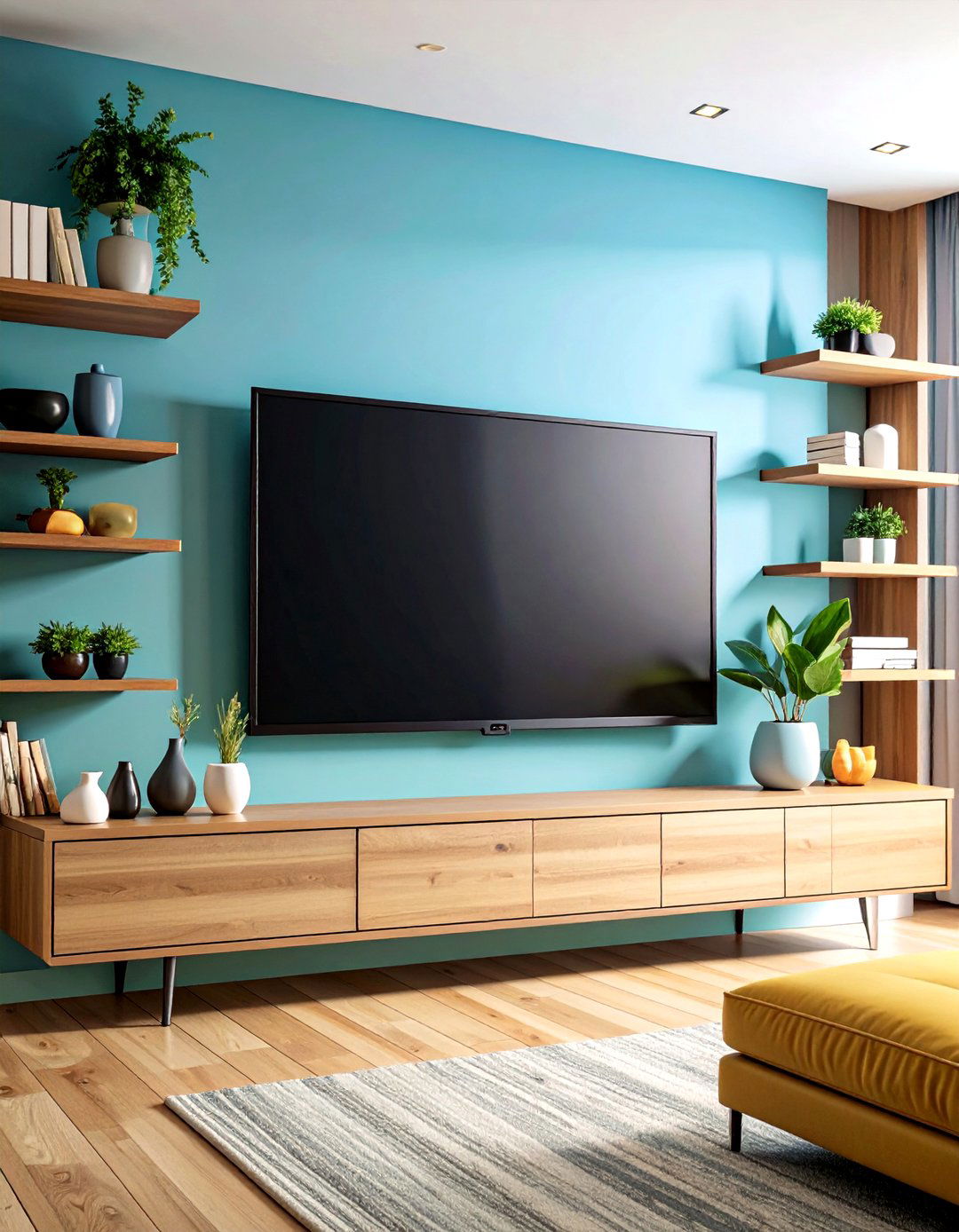
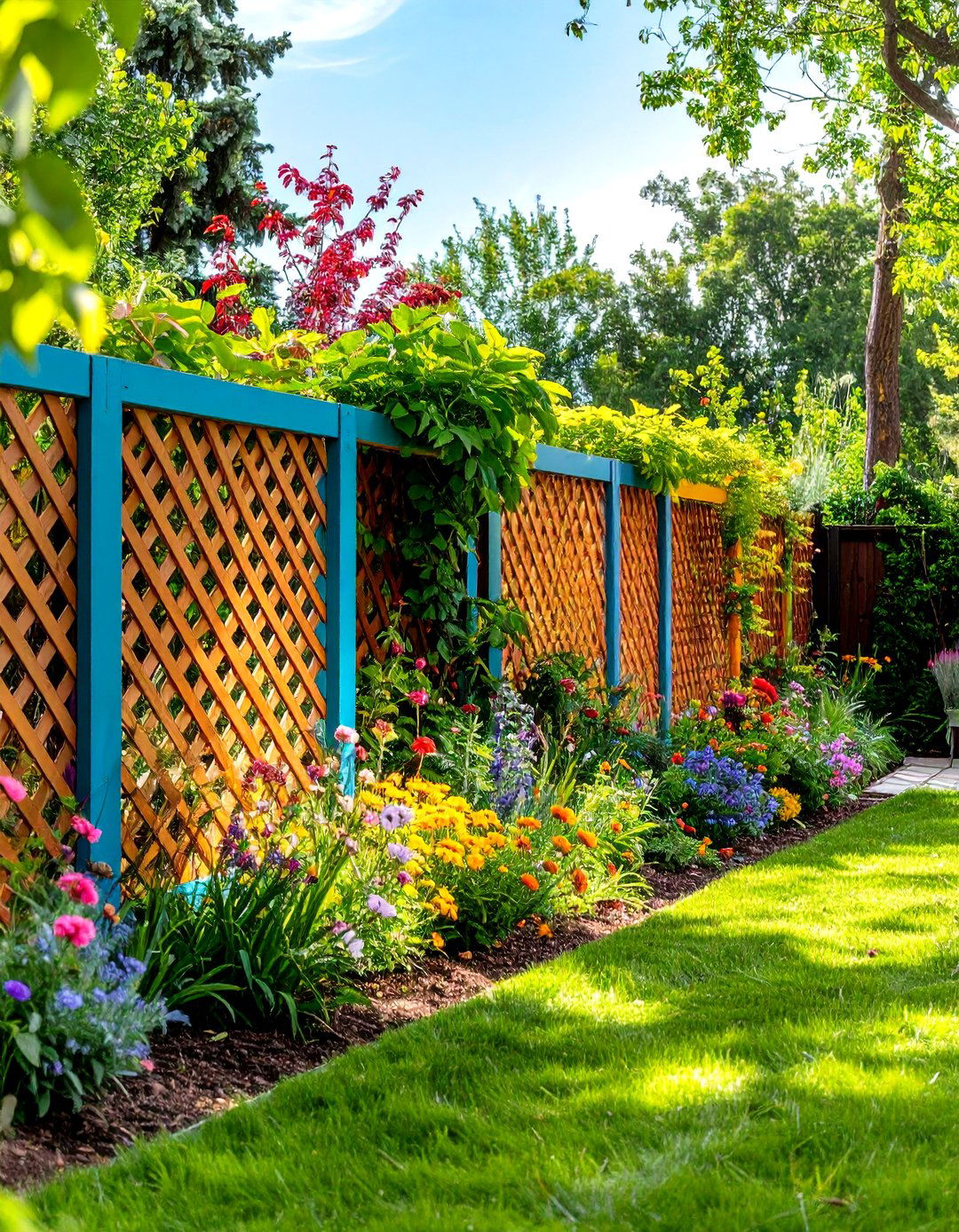
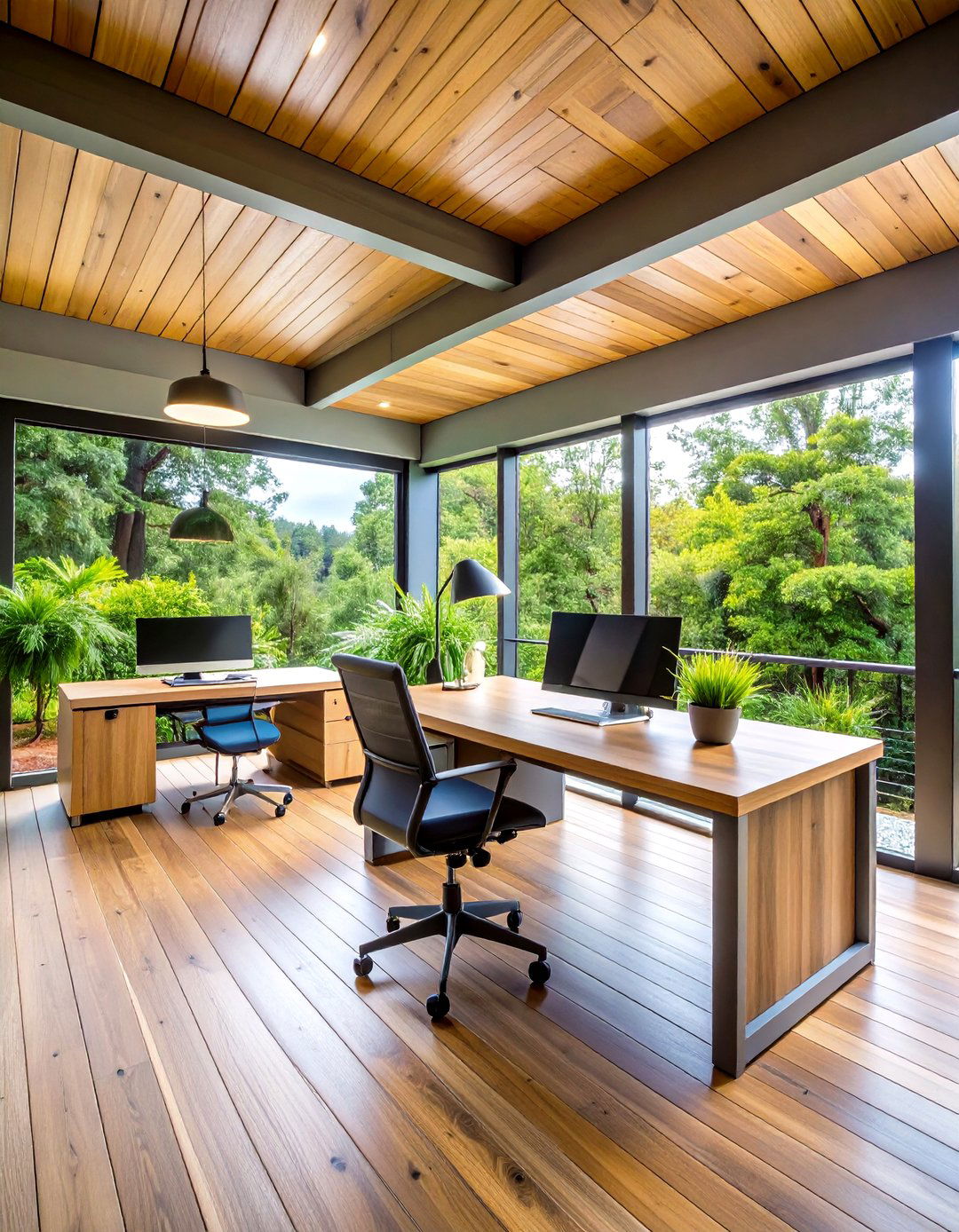
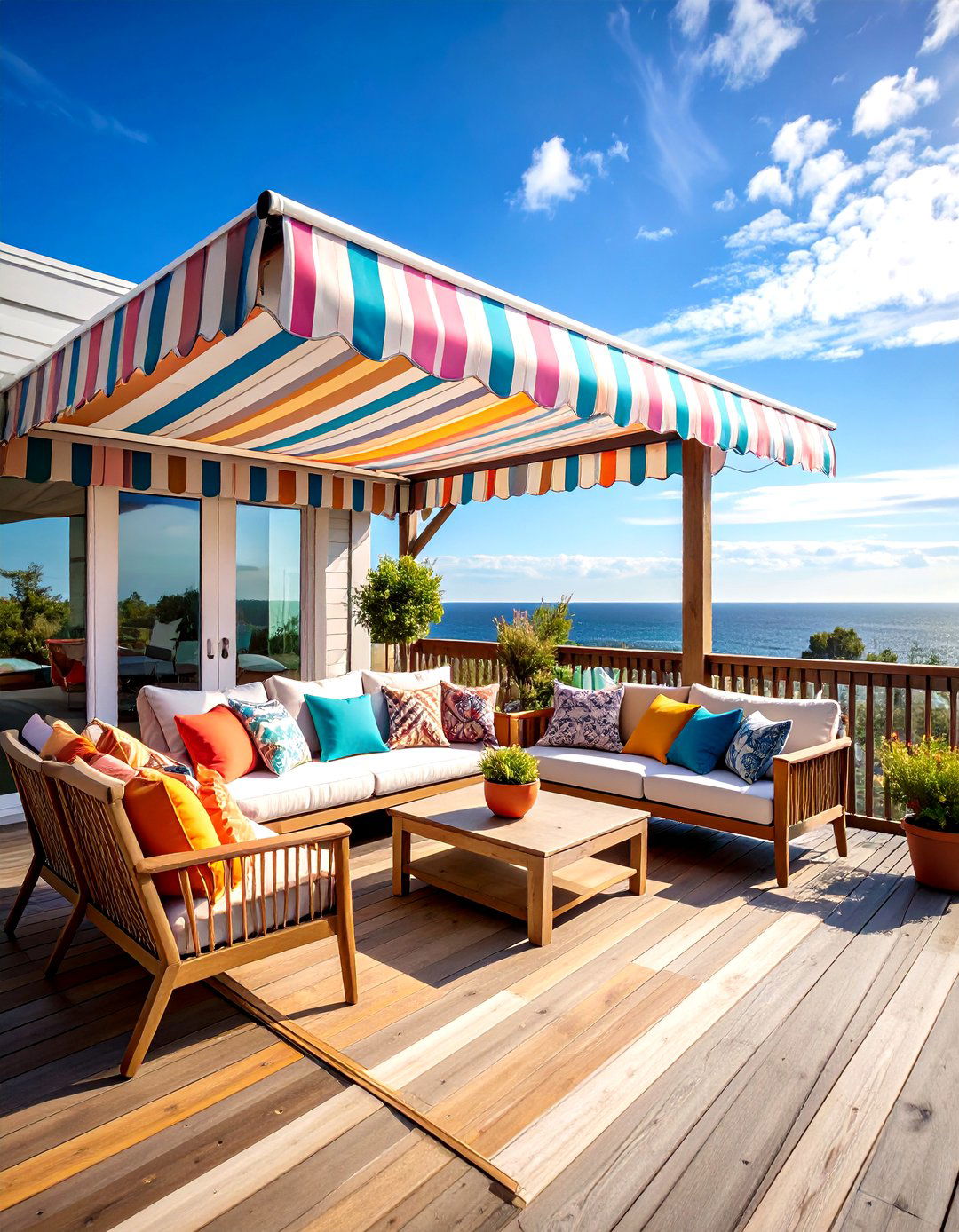
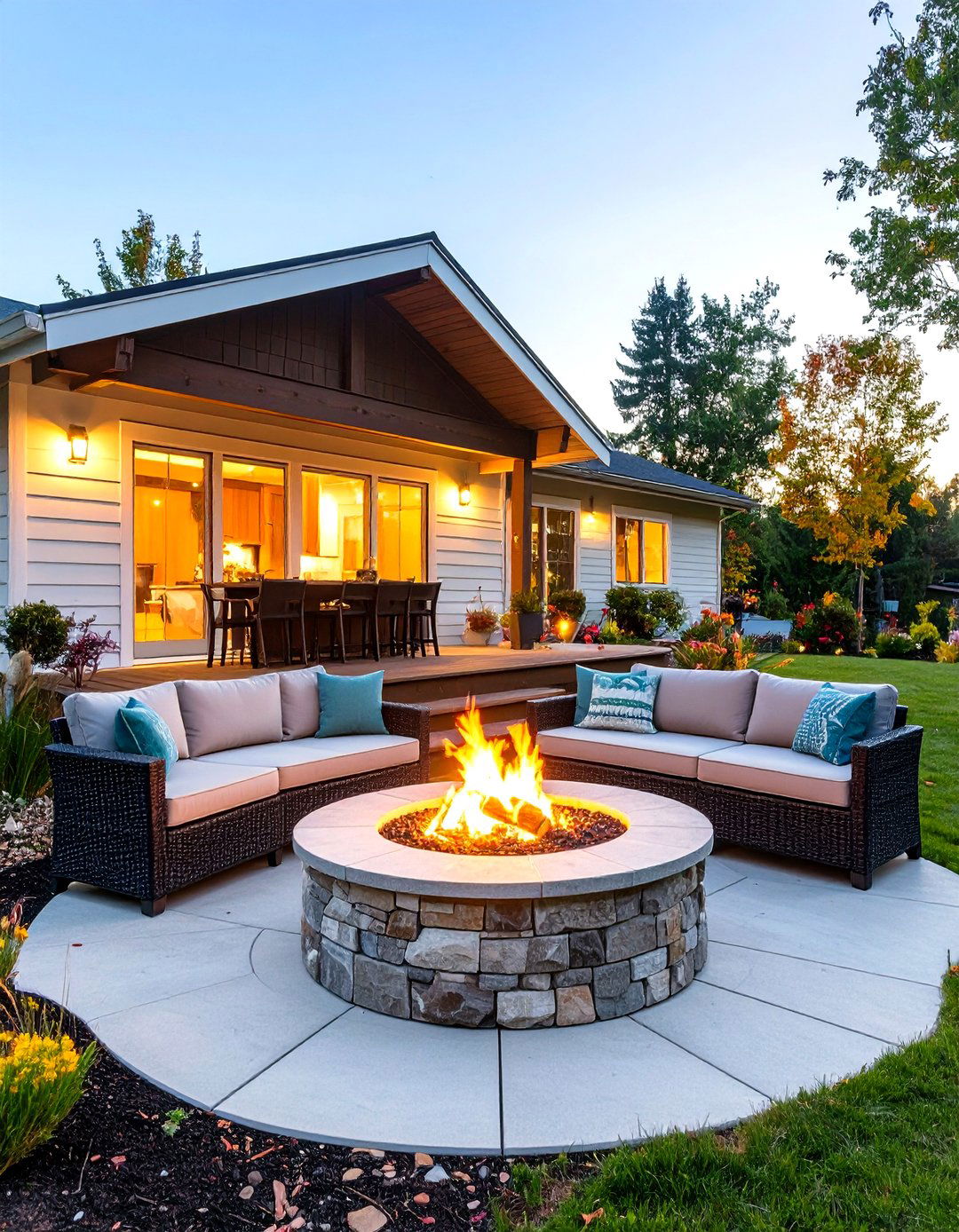

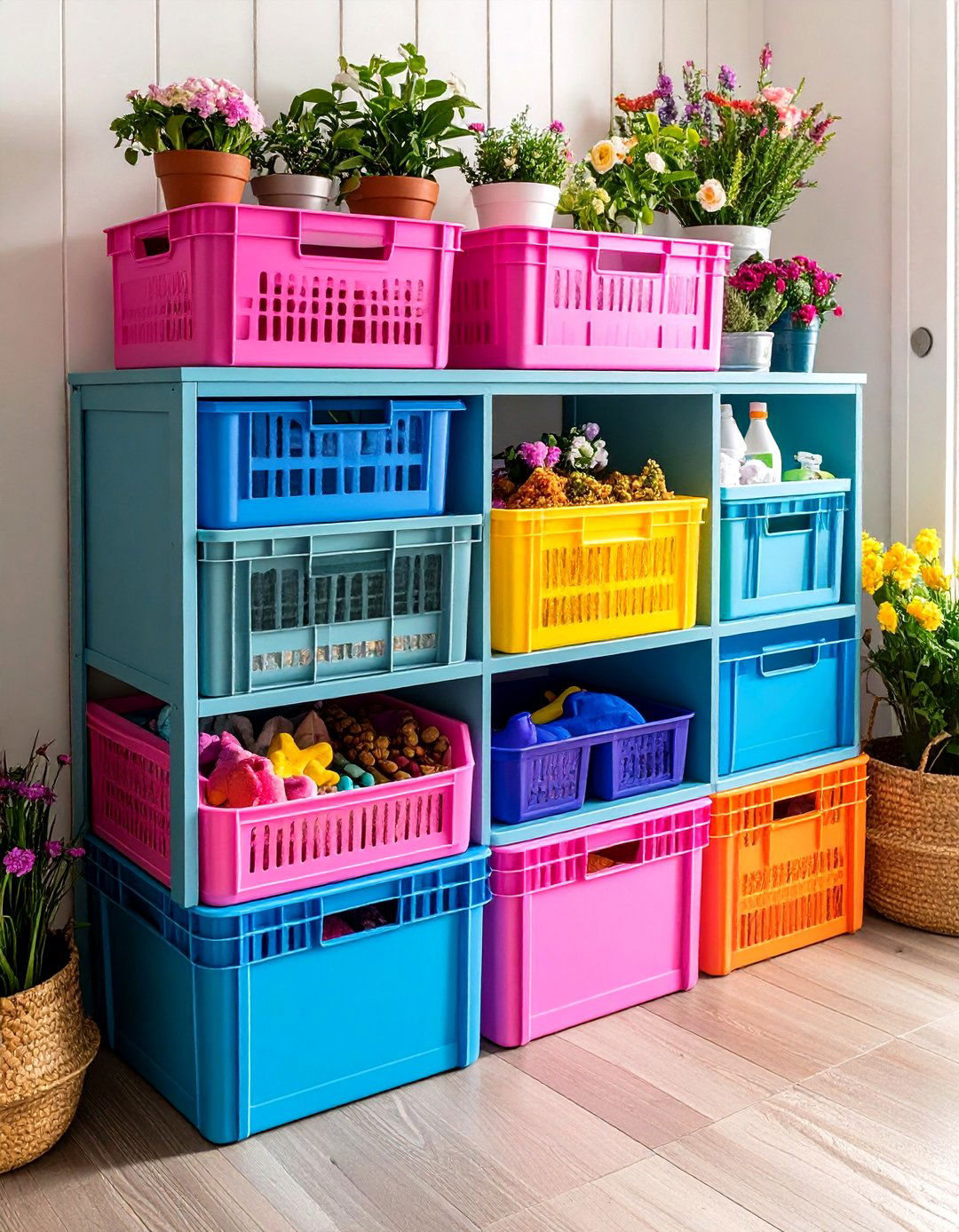
Leave a Reply